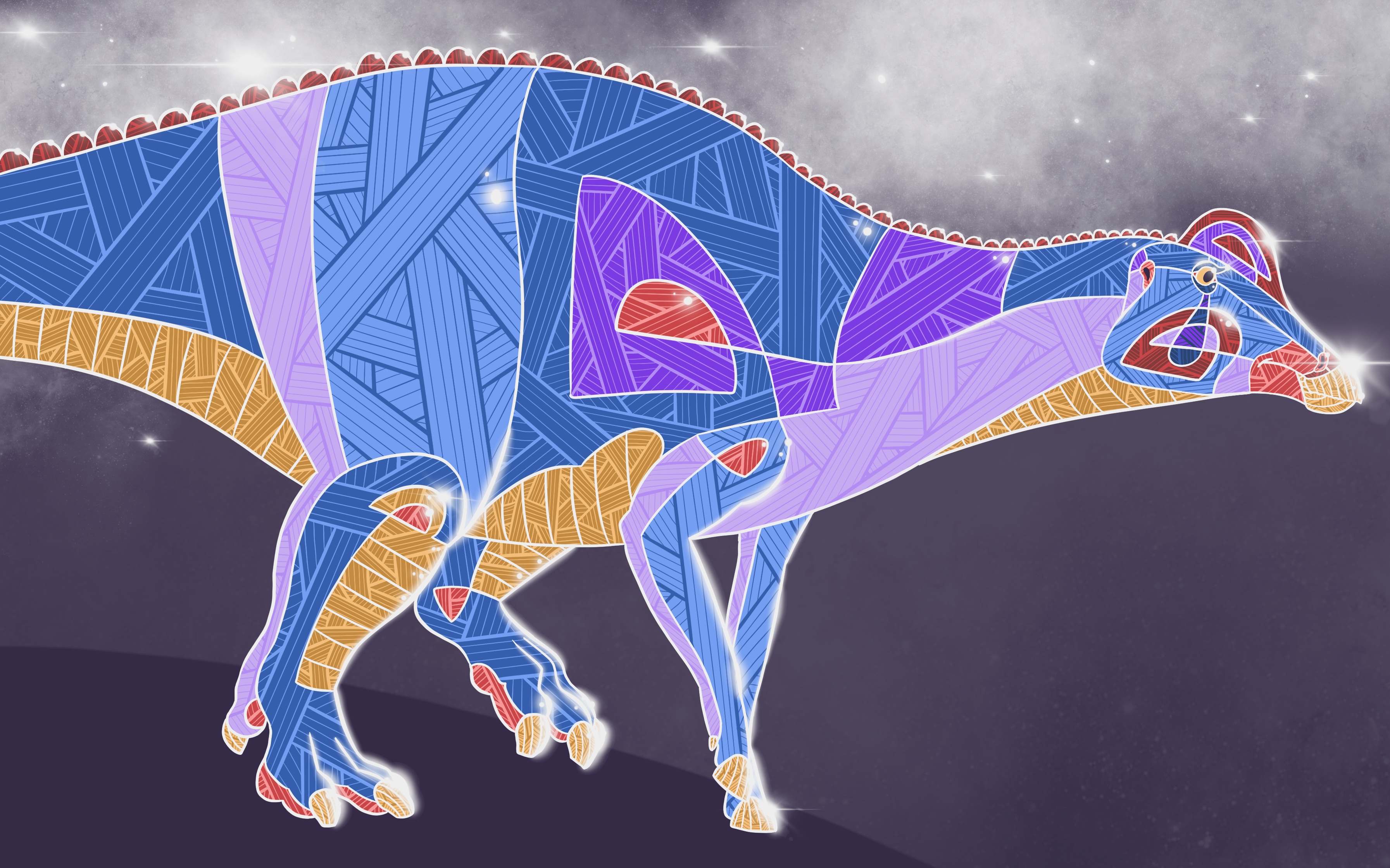For my 30th birthday, I made a special trip to Alberta, Canada, to visit the best paleontology museum in the world, the Royal Tyrrell. Most museums that have an extensive natural history section, like the Denver Museum of Nature and Science and the Smithsonian Museum of Natural History, also have other exhibits, like a taxidermy hall, a butterfly sanctuary, or a collection of hyper-realistic glass plants. But the Royal Tyrrell is focused solely on paleontology. Not only that, it’s out in the middle of nowhere, near the tiny mining town of Drumheller. The reason for this is that it’s where the fossils are found, and visitors to the museum can literally walk around outside and pick up dinosaur bones that weather out of the mud each time it rains. But it sure makes it difficult to visit! As part of the trip, we also went to Banff (a 3-hour drive from the museum), but honestly the museum was the reason for the trip.
This museum is so extensive that I’m going to split it into two posts. Never fear though, part 2 will be up in two weeks, and then my next post will follow two weeks after that. I won’t let the schedule slip!
Badlands Hike
On our drive from Calgary Airport, we passed through miles and miles of flat farmland, where combines were harvesting wheat and oats. It was unclear how canyons and hoodoos (tall skinny rock formations) were going to materialize out of the landscape, but sure enough, as we approached the town of Drumheller, the road dove suddenly into a canyon, and we were in the badlands.
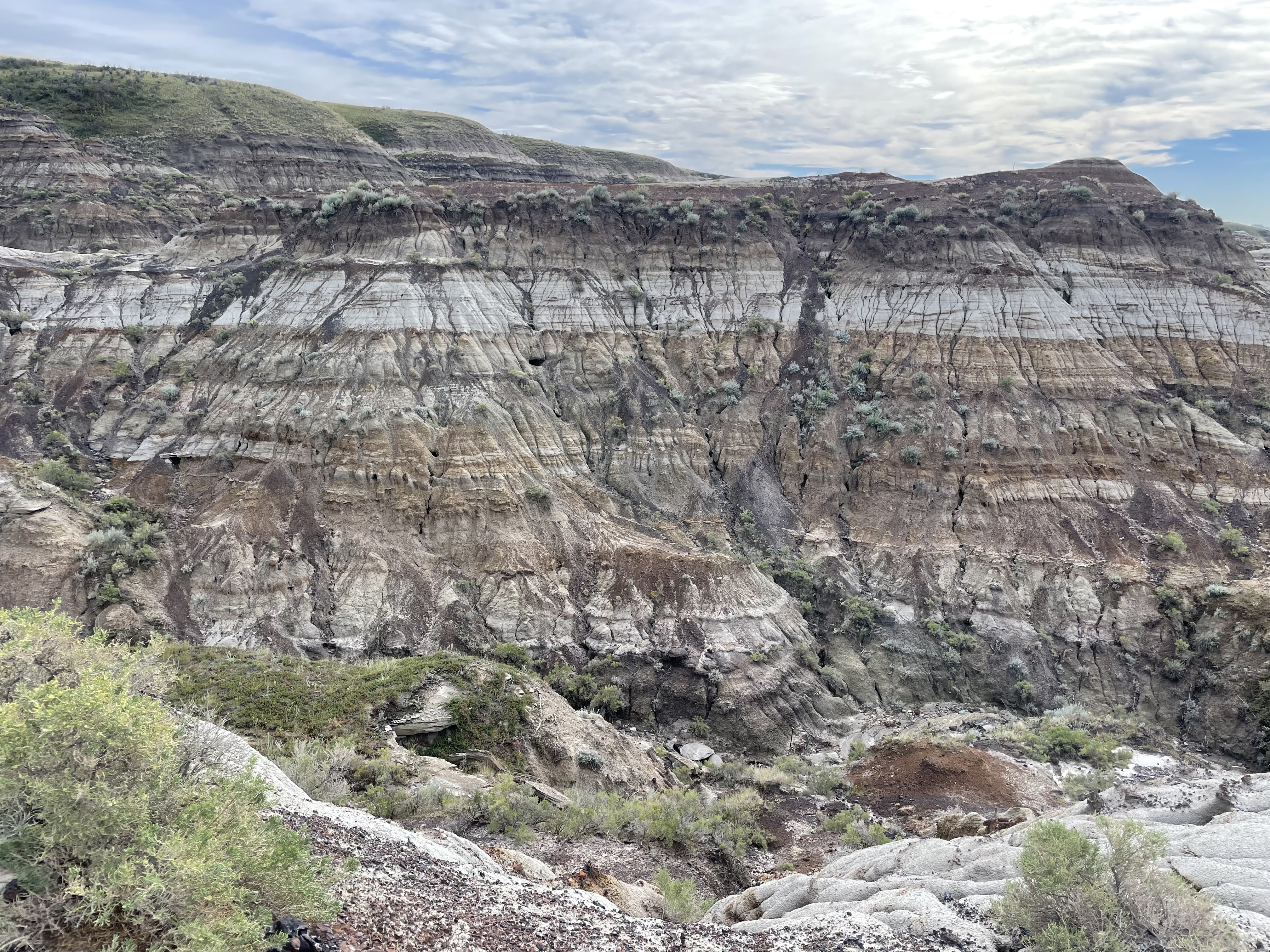
This area was carved out of the prairie by rushing meltwater from the glaciers at the end of the Ice Age. The term “badlands” comes from what the French settlers called it, “mauvaises terres a traveser”, which means “bad land to cross”. Imagine you’re rolling across the plains with your covered wagon, making good time, and then you see this terrain appear out of nowhere! There were even tiny cacti: prickly pears, the same type commonly used in xeriscaping in California, only reach minute sizes in Canada because they need to be able to hibernate through the brutal winters.
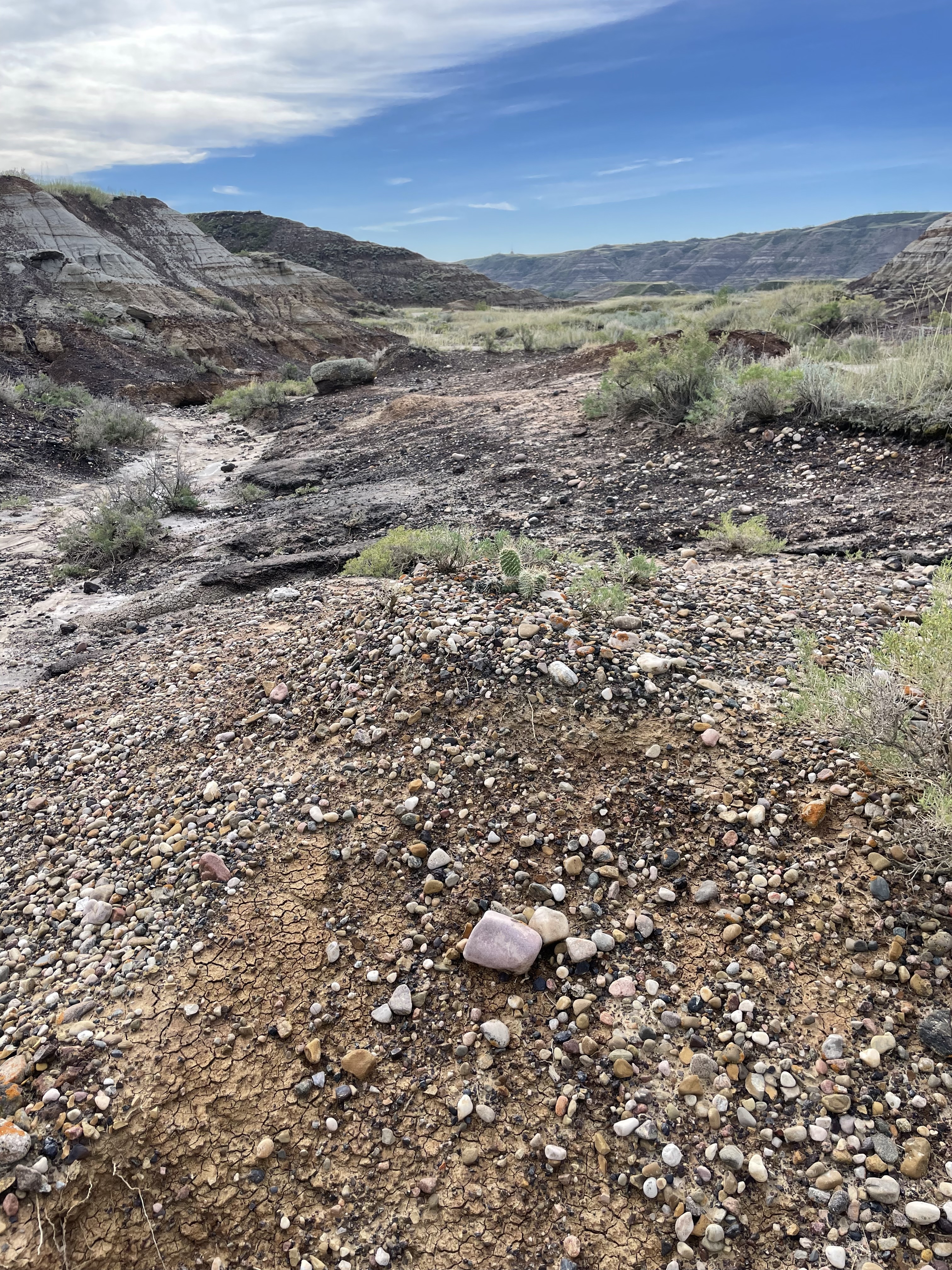
The town of Drumheller was very dinosaur-themed, with signs on the streetlights declaring it the “dinosaur capital of the world” and statues of dinos with varying levels of accuracy in front of stores and in people’s yards. We stopped at Tim Horton’s (the Canadian version of Dunkin’ Donuts) for coffee and found dino-related decorations in there too, including a statue of an Albertosaurus wearing a hockey jersey.
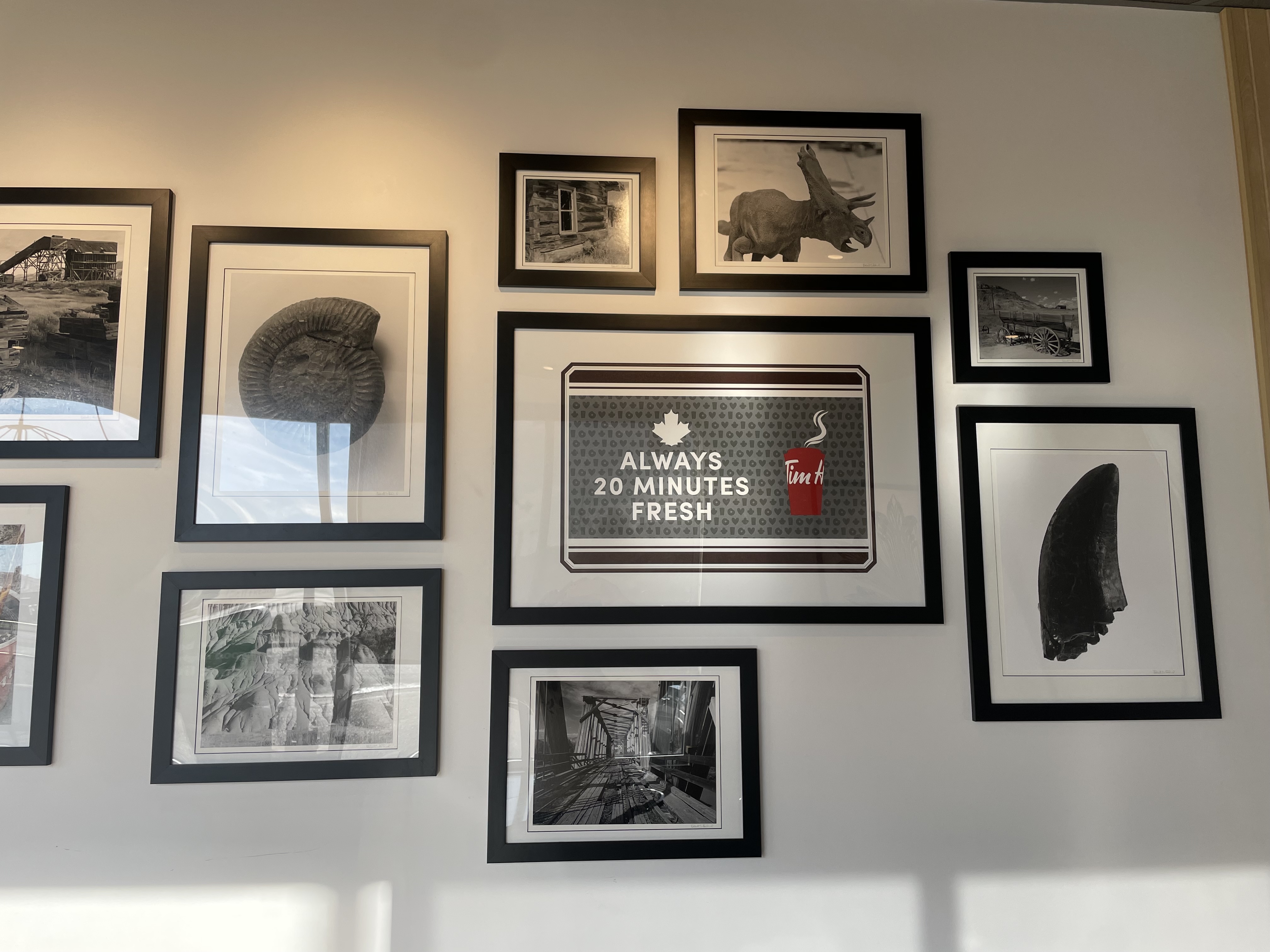
Walking up to the museum, we were greeted by a statue herd of a dozen or so adult and baby Pachyrhinosaurus, a horned dinosaur with a lumpy boss on its nose.
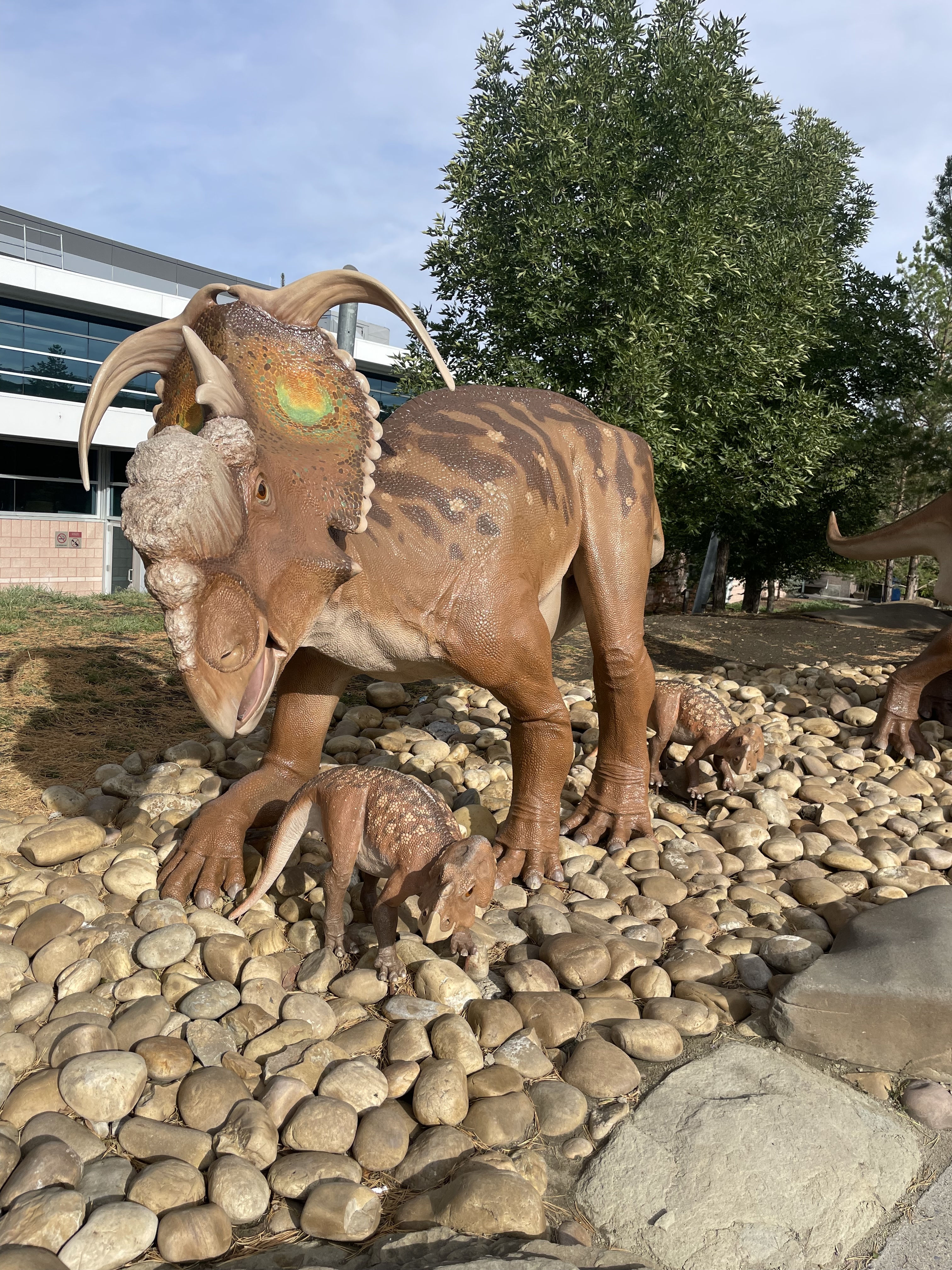
I can’t find anything to fault about these statues. Erect stance, babies with believable ontogenetic differences in the frills and proportions from the adults, clusters of “nipple scales” on the body, a splash of color on the frill but otherwise a plausible coloration for a medium-sized animal. They even had cloacae. Some people speculatively depict Pachyrhinosaurus specifically as having been woolly, or with the nasal boss supporting a large keratinous horn like a rhino, but those definitely don’t represent the consensus view. I also appreciate how many unique statues there were. Pachyrhinosaurus fossils are often found in groups, showing that they lived in herds, but it takes effort to sculpt this many individuals. 10 out of 10. A great start!
The first thing we did upon arriving was a guided hike through the badlands in which a museum docent named Clem talked about the geology and pointed out where dinosaur bones were laying around on the ground. Here’s a limb bone in a creek bed.
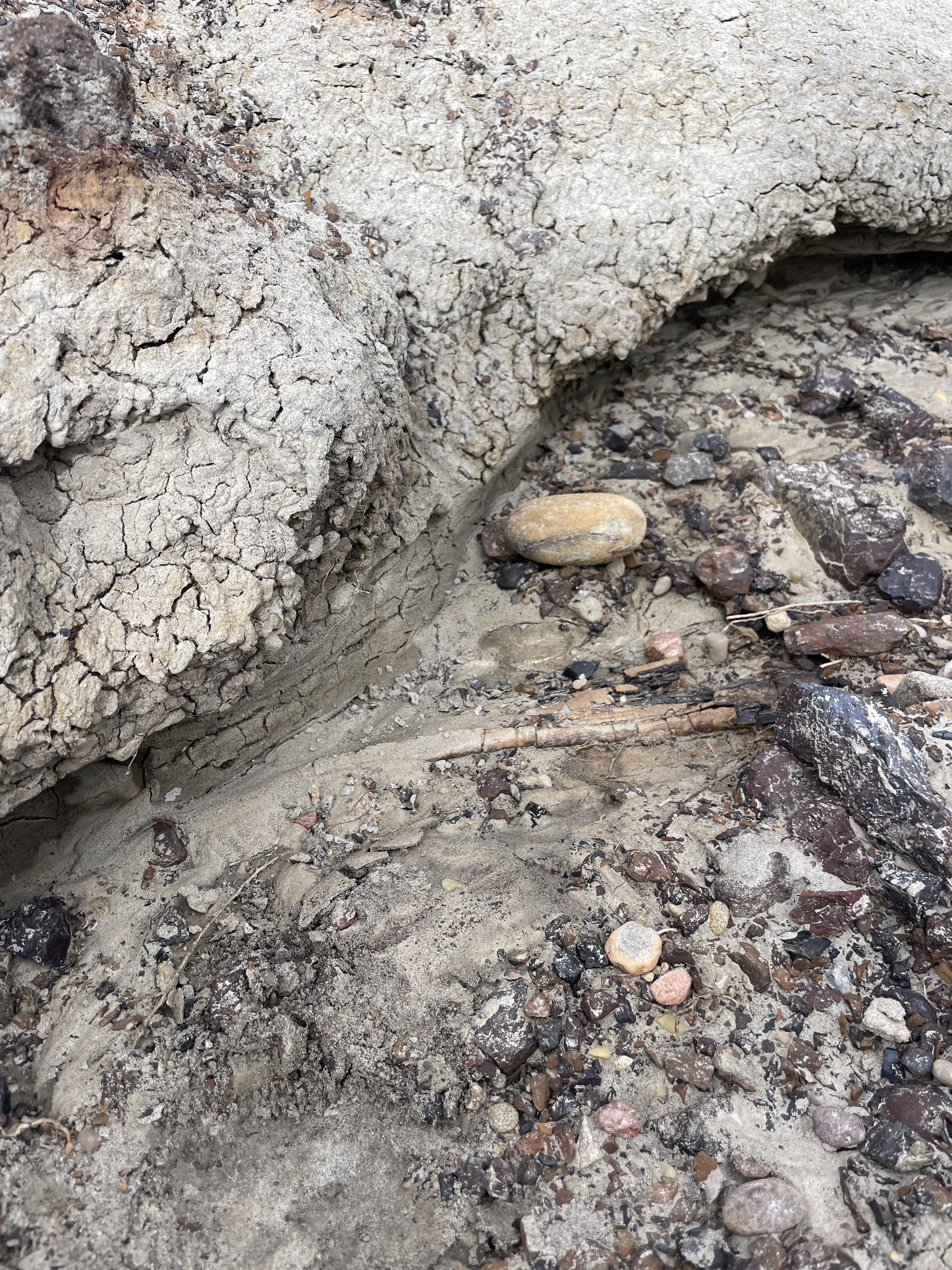
Most of the bones we saw were either in too poor of shape to be worth studying, or were too difficult to extract. In one case, a group of ribs had become more exposed after the most recent rain, so the docent said he would notify a scientist to come and take a closer look, but most of the bones would likely not be studied. This hadrosaur femur is embedded in ironstone, a byproduct of fossil bacteria that contains a lot of iron and therefore rusts, and is also very hard.
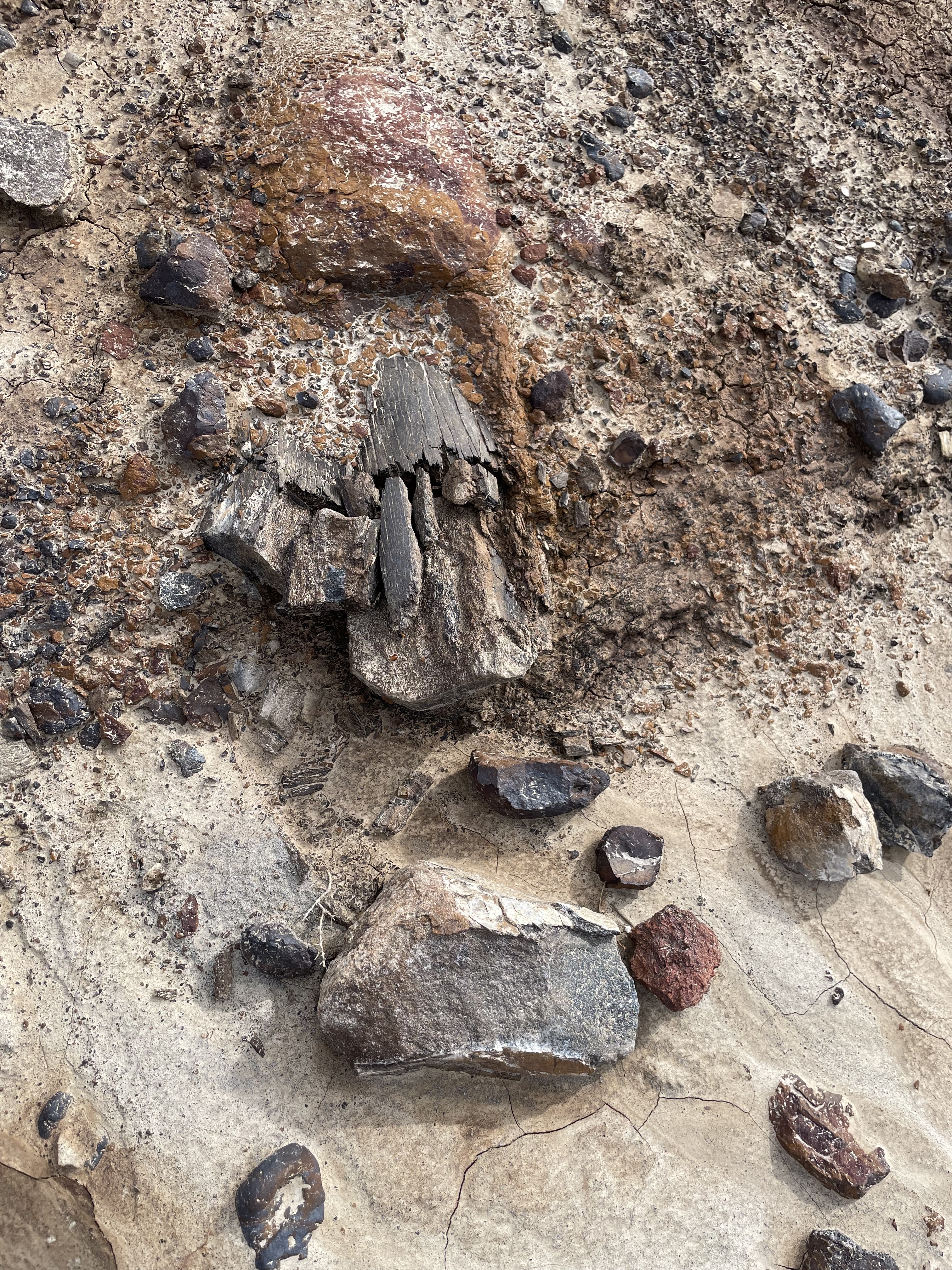
One of the more impressive outdoor fossils was a collection of large bones from a single large hadrosaur, probably Edmontosaurus. In this picture, you can see the head of the bone poking out some distance from the exposed length of it. It extends back into the rock some distance too. Foot for scale.
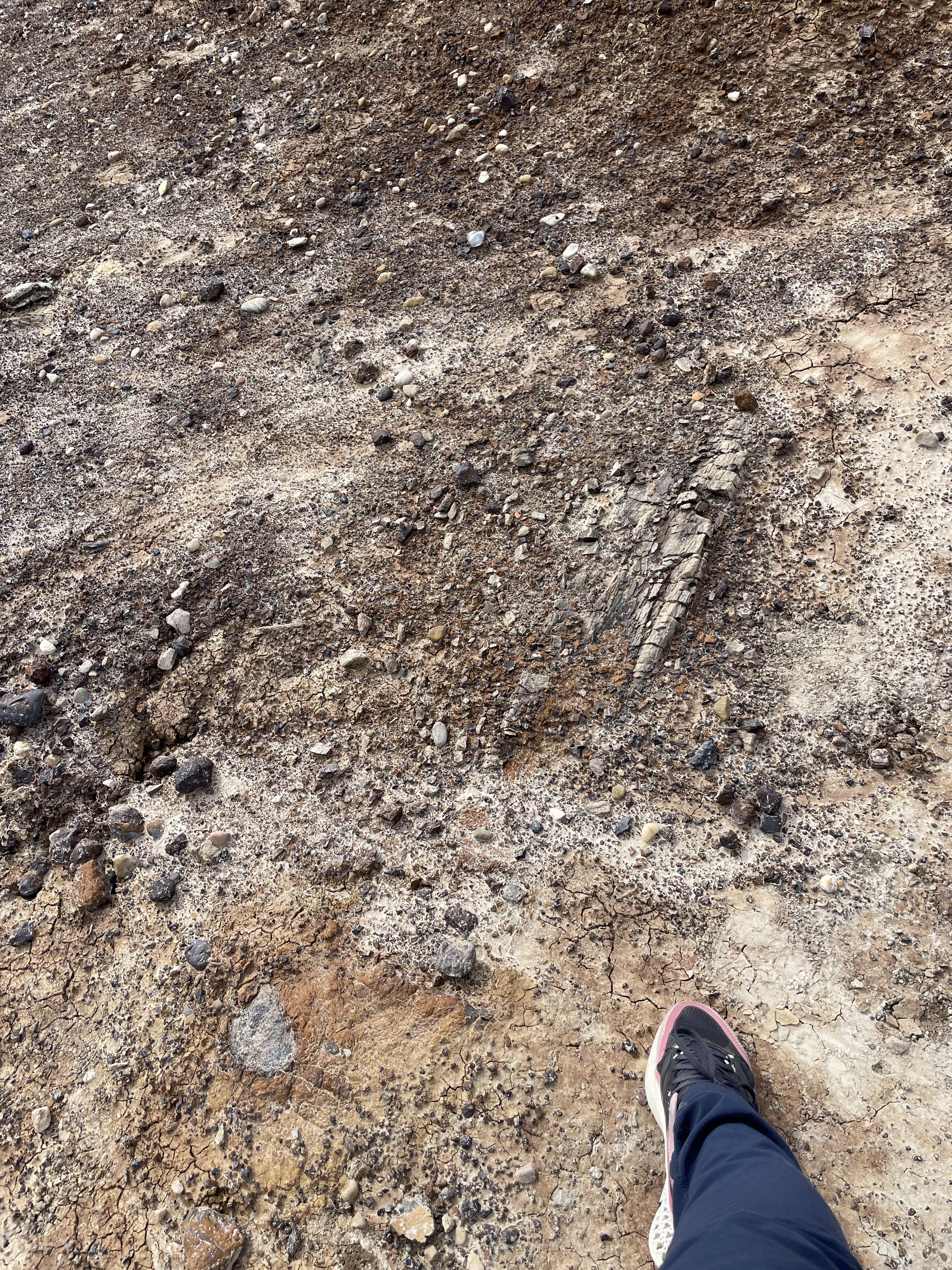
One of this individual’s vertebrae was sitting out on top of the pile as well. I asked the docent which one it was, and he guessed it was a quarter of a sacral vertebra (above the hips) and told me which way it would have been oriented in the animal.
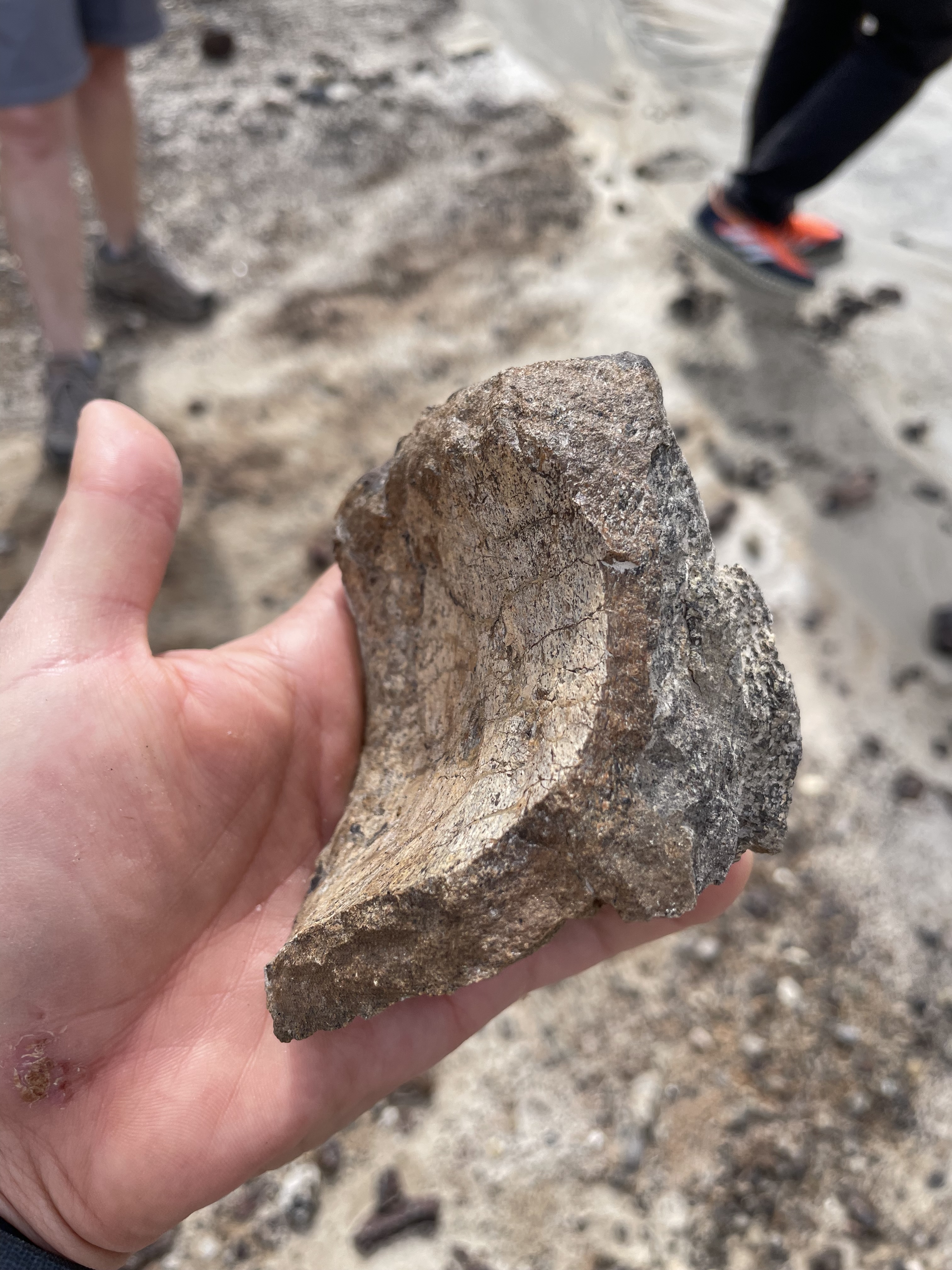
I also found a couple pieces of petrified wood in the creek beds, which the docent identified for me as not-bone.
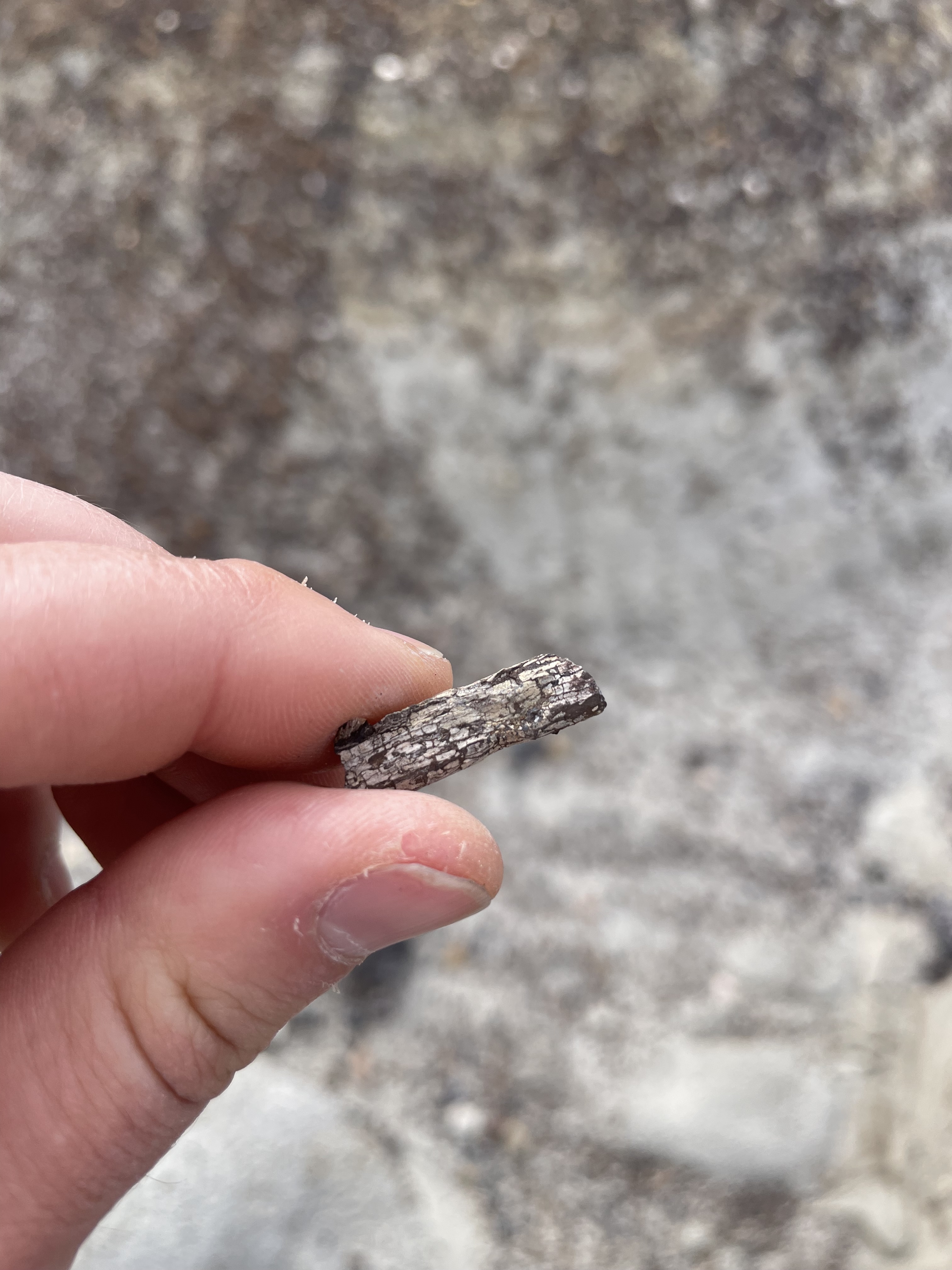
Overall, the badlands hike was a unique experience I have not seen offered anywhere else. The guide was very knowledgeable and happy to answer my barrage of questions about the strata, the fauna, and the methods of doing science in the area. 10 out of 10, would recommend.
Entrance Hall
A statue of Albertosaurus, the smaller and earlier cousin of Tyrannosaurus that is the namesake of the province, guards the entrance to the museum.
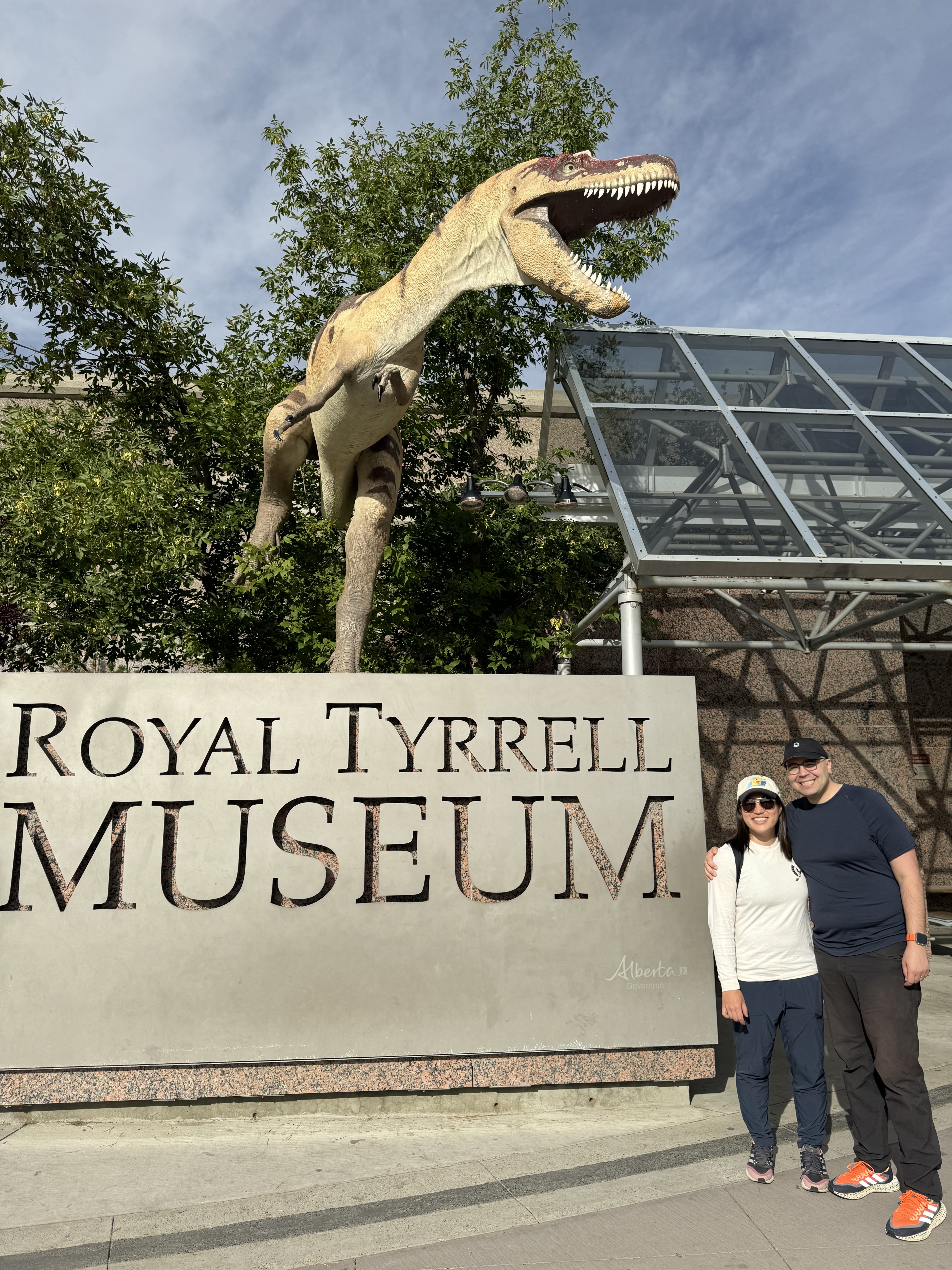
While this is a cool statue, it’s much less accurate than the Pachyrhinosaurus that were also outside. It has scrawny arms with pronated hands, a shrinkwrapped, overly narrow body with its ischium (rear-pointing hip bone) protruding, and generally not enough skin–its legs go all the way up to the hip joint. Still, it’s not terrible, and its face and coloration are attractive. 7 out of 10.
Dominating the entry hall of the museum were four more life-sized statues of Albertosaurus, these ones built with more attention to scientific accuracy.
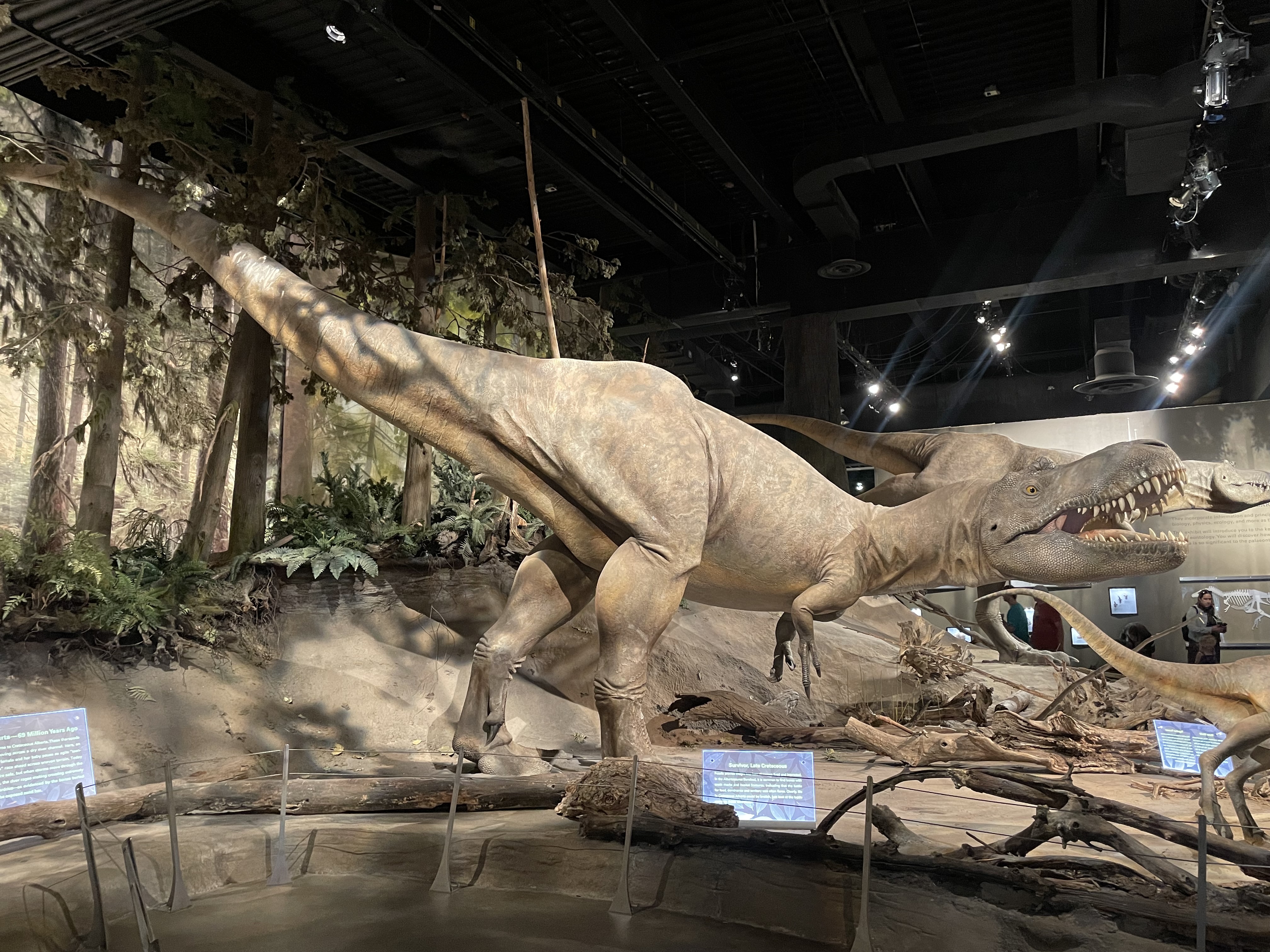
There’s a lot to like here, but also a few nits to pick. The posture of the arms and legs is generally good, and they look appropriately muscled and not shrink-wrapped. I like the pads on the bottoms of the back feet and the subtle cryptic coloration befitting an ambush predator in a closed habitat. However, there’s just something… off… about the torso and neck posture, and the facial expression. Could it have tilted its head that far up without also tilting the neck in that way? Its torso looks disproportionately slender and tapered relative to its chonky legs. Why is its eye so bugged out? If an animal looks down, it tends to close the top eyelid and not reveal the white of the eye above the pupil. Is this mother supposed to be chastising her baby, or protecting it from something? 7 out of 10.
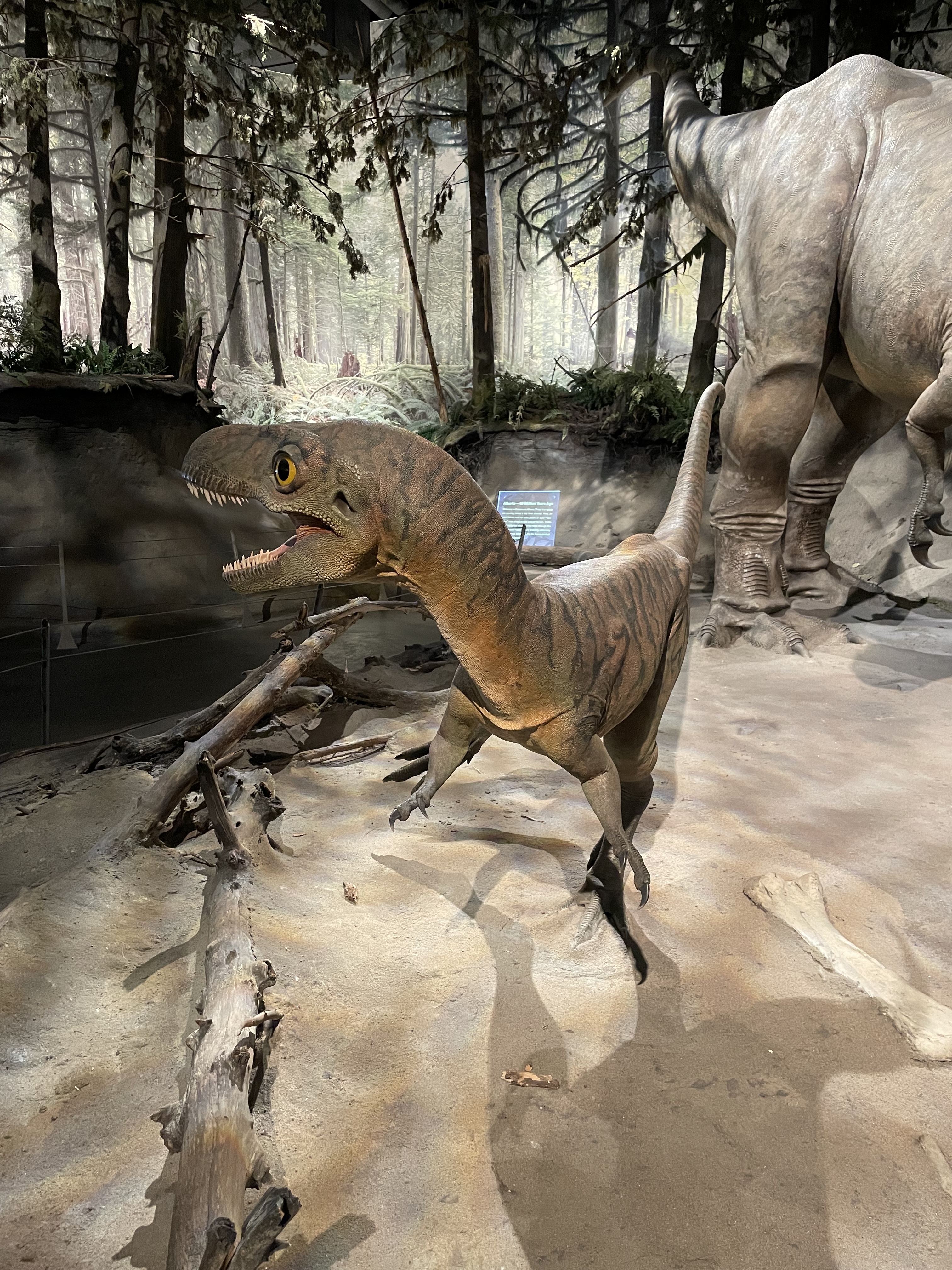
Speaking of, here’s the baby. I think the pose and expression here is a lot more natural, and the proportions are right for a baby tyrannosaur: it’s much slenderer and leggier than the adult, as opposed to the one in Jurassic Park 2 which was just a scaled-down adult model with enlarged eyes. It also has stronger cryptic coloration (bolder stripes) than the adult, which is a phenomenon we see in many animals today, like ostriches and deer. There was a poster in the museum showing tyrannosaur ontogenetic progression that depicted fresh hatchlings as fluffy but older juveniles like this as scaly; while we have skin impressions from adult Tyrannosaurus showing small patches of scaly skin in some places on the body, it’s not known whether the babies would have had any fluff or not, and if or when they would have lost it. So I can’t fault the artist for not including it here, though I personally would have. 10 out of 10.
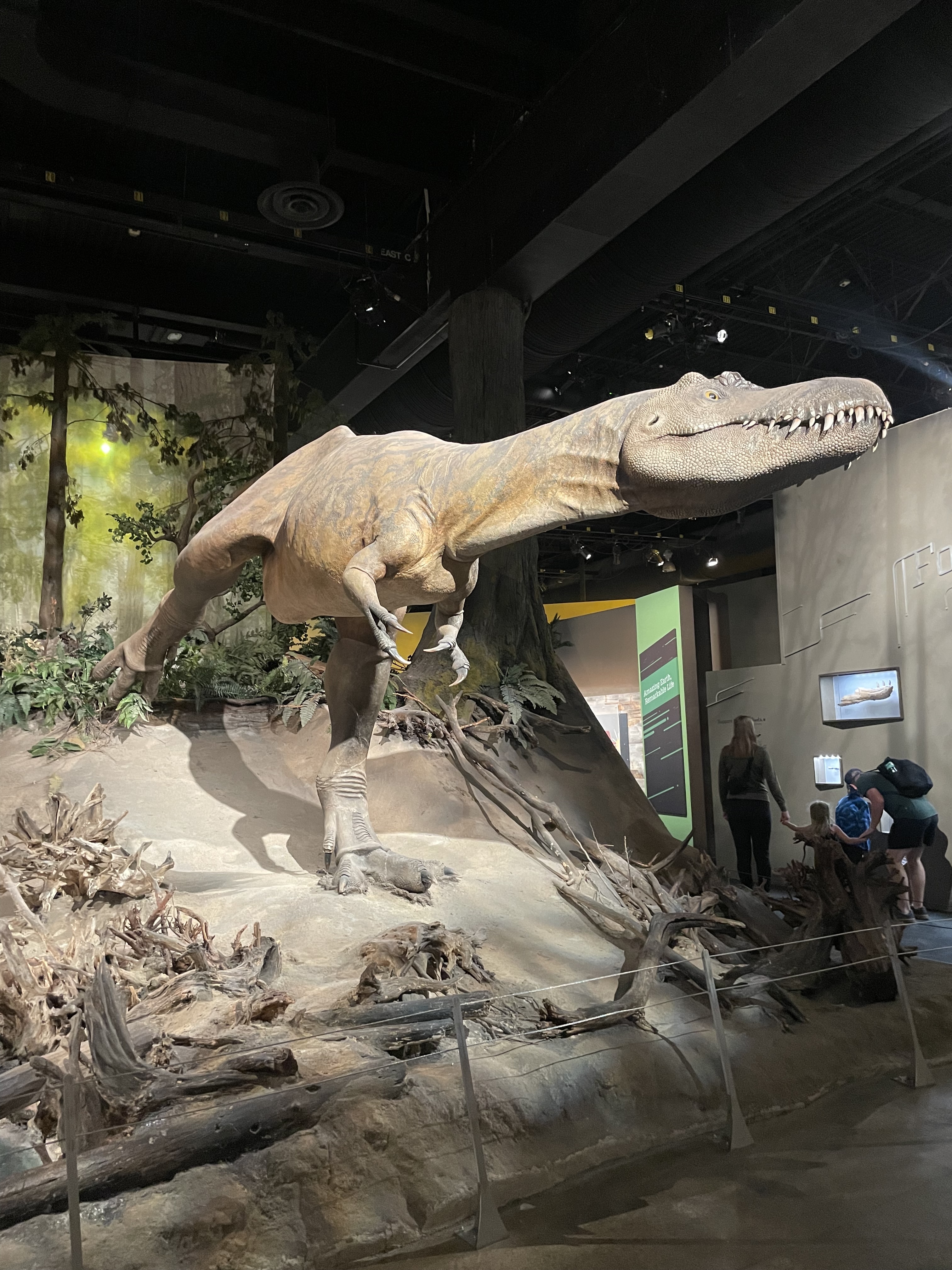
Also in the entry hall were two Albertosaurus subadults, slightly smaller and much more lightly-built than the big mother. I like the dynamic pose here, suggesting that unlike the bulky adults, subadults would’ve been fast runners, and I like the inclusion of a patagium (flap of skin) connecting the knee to the body, like a dog. I also like how some of the teeth are growing in while others have fallen out, and how the sand around its planted foot is disturbed, nice touches of realism. However, I’m not a fan of the teeth-sticking-out look. While by phylogenetic bracketing we would expect dinosaurs not to have lips, since neither of their closest living relatives, birds and crocs, have them, there are no modern land animals whose non-tusk teeth stick out to this degree. Generally, drying out is bad for dental health, which is why aquatic animals don’t need lips but terrestrial animals do. Tasmanian devils’ canines protrude, but as a mammal, it has a mobile, wet tongue it can use to lubricate them as needed. Tyrannosaurs most likely had simple, flat tongues (which these statues are shown to have) that would not have been able to serve that purpose. While the consensus is currently on the side of lips, some paleontologists argue that osteological correlates on the skulls of related genera like Daspletosaurus show that these animals did not have lips. Therefore, while it’s not settled, I’ll deduct a point for taking the less-likely, and also outdated, route here. 9 out of 10.
First Exhibit
The next area contained a few very impressive fossils that simply showed off the museum’s massive collection, a “One Day At Work” section telling the stories of people who found fossils in the area during construction work, a few fossils that were used to explain fundamental concepts of evolution, and the fossil prep lab, where you could look through a window at the work being done and talk to a preparator.
Prize Specimens
This nearly-complete Triceratops skull gave the famous Borealopelta specimen a run for its money in terms of the record number of hours it required to prepare. A preparator spent 6500 hours removing matrix (surrounding stone and dirt), piecing together, and treating this fossil (7000 for Borealopelta). Such a huge, complete skull! Millions of years ago, this giant creature was chomping through plants and showing off its massive frill. 11 out of 10. I feel privileged to have seen this.
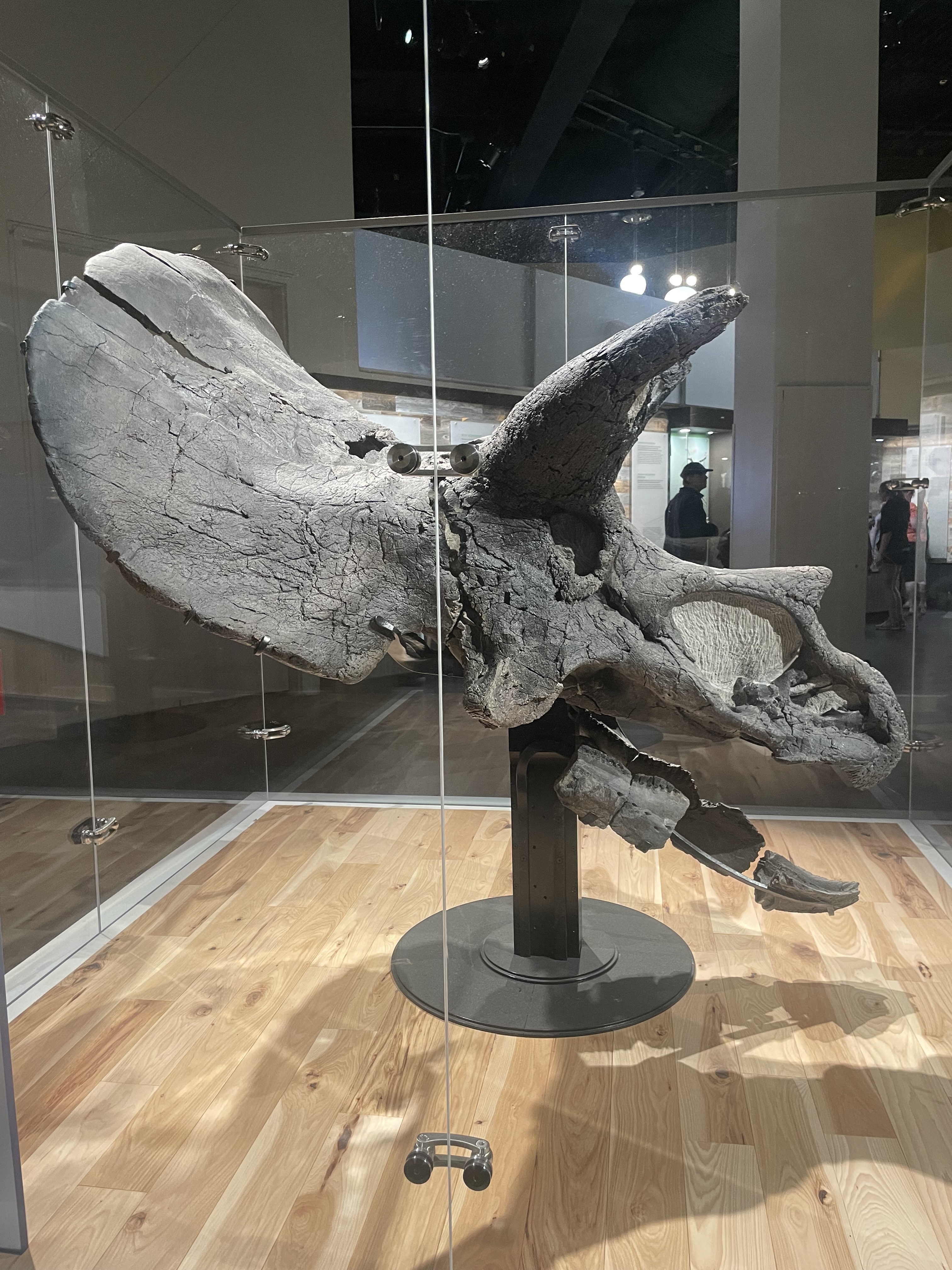
The centerpiece of the entry exhibit is the Tyrannosaurus rex specimen known as “Black Beauty” because the manganese present in the rock turned the bones black during fossilization. It’s in the same characteristic death pose, and there’s something raw and visceral about seeing it displayed this way rather than as a mounted skeleton in a lifelike pose (though the museum has one of those too!).
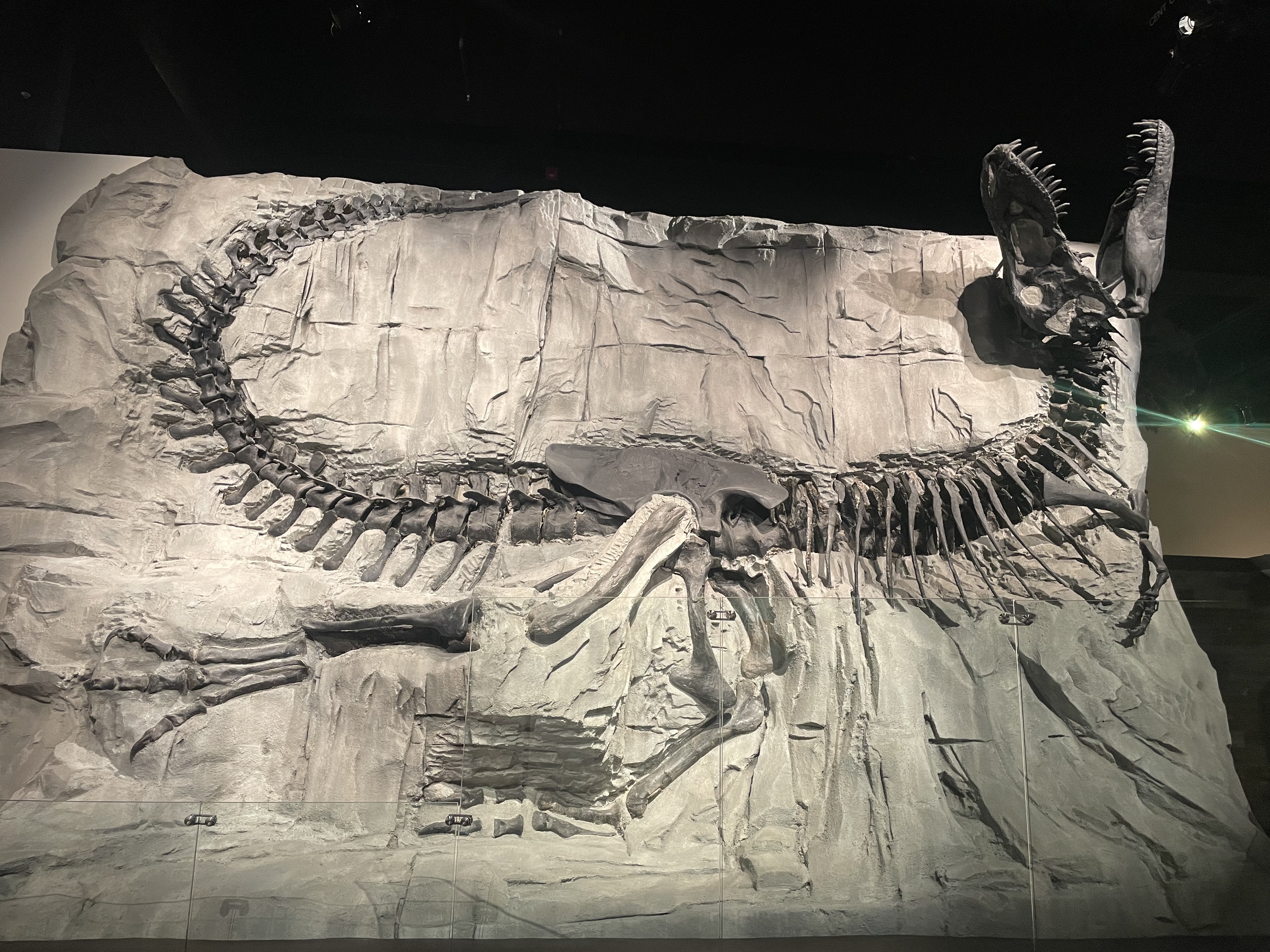
11 out of 10, bucket list specimen. I also love the fact that, even though its skull was too heavy to mount this way and the skull shown here is a cast, the original skull is present at the base of the slab in the same exhibit (not shown in this photo). Full disclosure and no skimping. Mad respect!
And now the pièce de résistance, the specimen I flew all the way to Canada to see: the Borealopelta mummy!
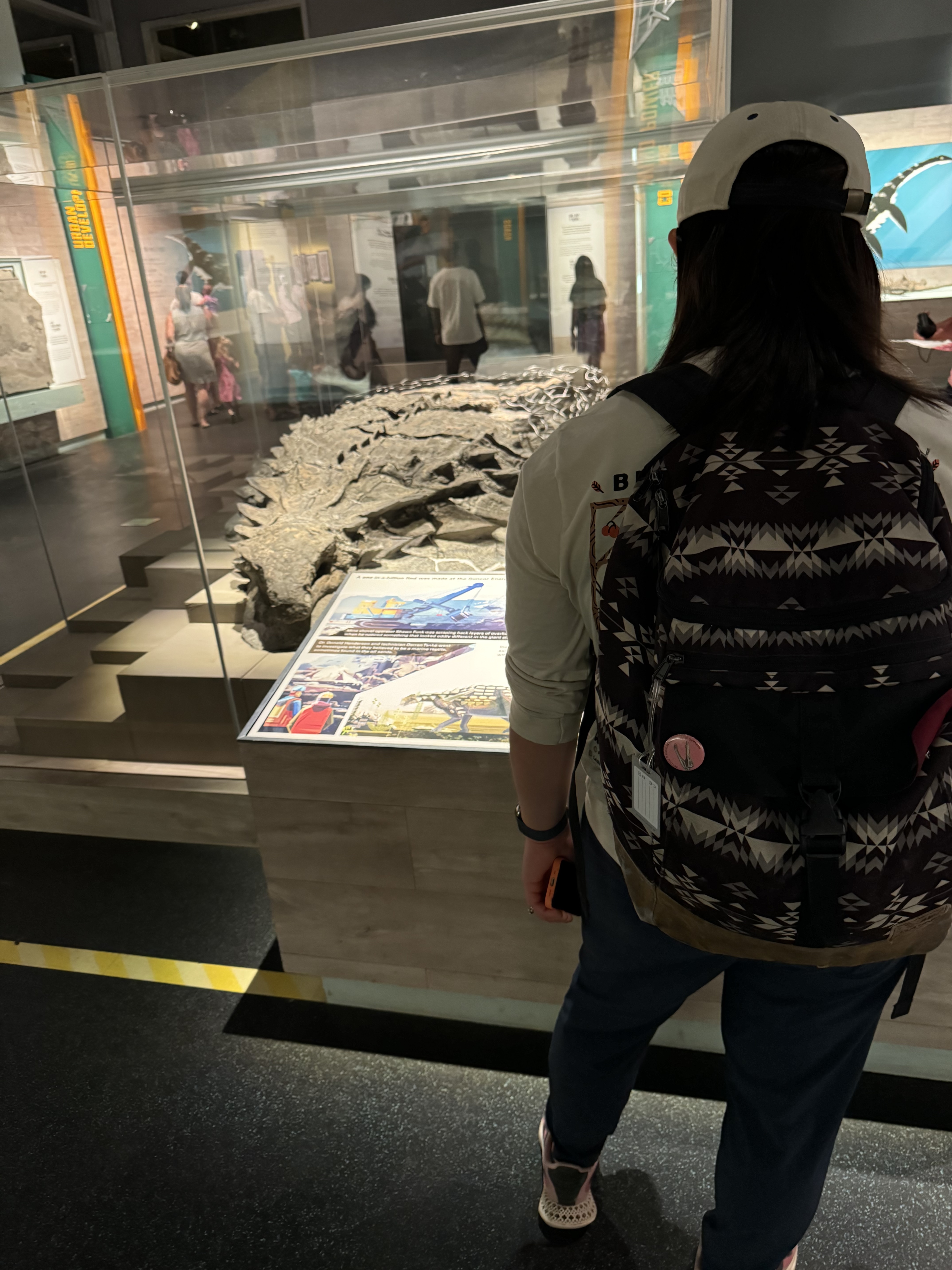
I’ve drawn and written about Borealopelta before, and now I finally got to see it! This nodosaur (clubless armored dinosaur) is so intact that its skin cells are visible under a microscope, allowing scientists to know what color it was, which is very rare among non-feathered dinosaurs (the only other is Psittacosaurus). Its last meal–ferns and bits of charcoal–is also preserved in its gut. There are a wealth of studies that have been and continue to be published on just this one remarkable specimen! 11 out of 10.
Borealopelta’s species is named after the preparator who spent 7000 hours over five years preparing it, Mark Mitchell. I asked Clem the badlands guide if Mark Mitchell still worked there and he said, “Of course. Mark will always work here.”
Evolution and Taphonomy Concepts
This next display case contained one of the many Albertosaurus skulls in the museum’s collection next to a cast of a Carnotaurus skull, along with a coyote skull and a thylacine (extinct marsupial “wolf”) skull, with a plaque explaining about convergent and divergent evolution. While this does sort of get the point across, as thylacines and canids are a classic example of convergence while tyrannosaurs and abelisaurs have diverged due to different hunting strategies, I think this display was just an excuse to put out another Albertosaurus skull. It’s also not exactly an apples-to-apples comparison, and could’ve benefitted from other examples, like the skull of a mouse or something (i.e., an animal more closely related to a coyote than the thylacine is, but whose skull looks nothing like the coyote skull). 7 out of 10.
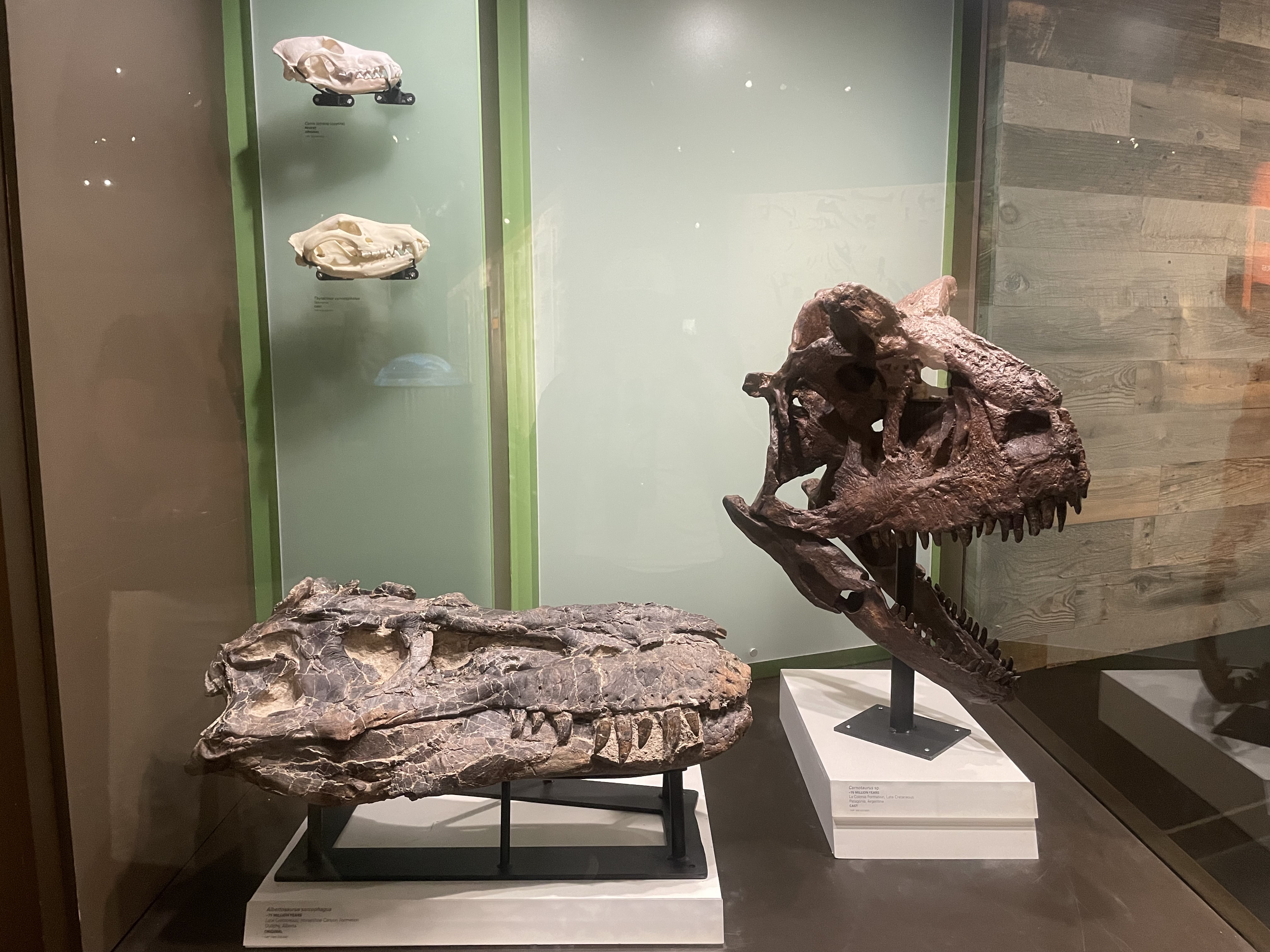
Here’s a case with some examples of marine life in the area: a Latoplatecarpus (mosasaur) skull and an iridescent ammonite (shelled squid relative). I don’t recall there being much info about these, but maybe I just didn’t see the sign. But the shiny shell is super cool. It’s made of ammolite, a gemstone born of the fossilization process (in life, the animal would not have been shiny like this) that is only known to occur here, in ammonites from the Cretaceous Western Interior Seaway. I can’t grade this display because I’m not sure there wasn’t info about it. It probably was supposed to explain something general about evolution…
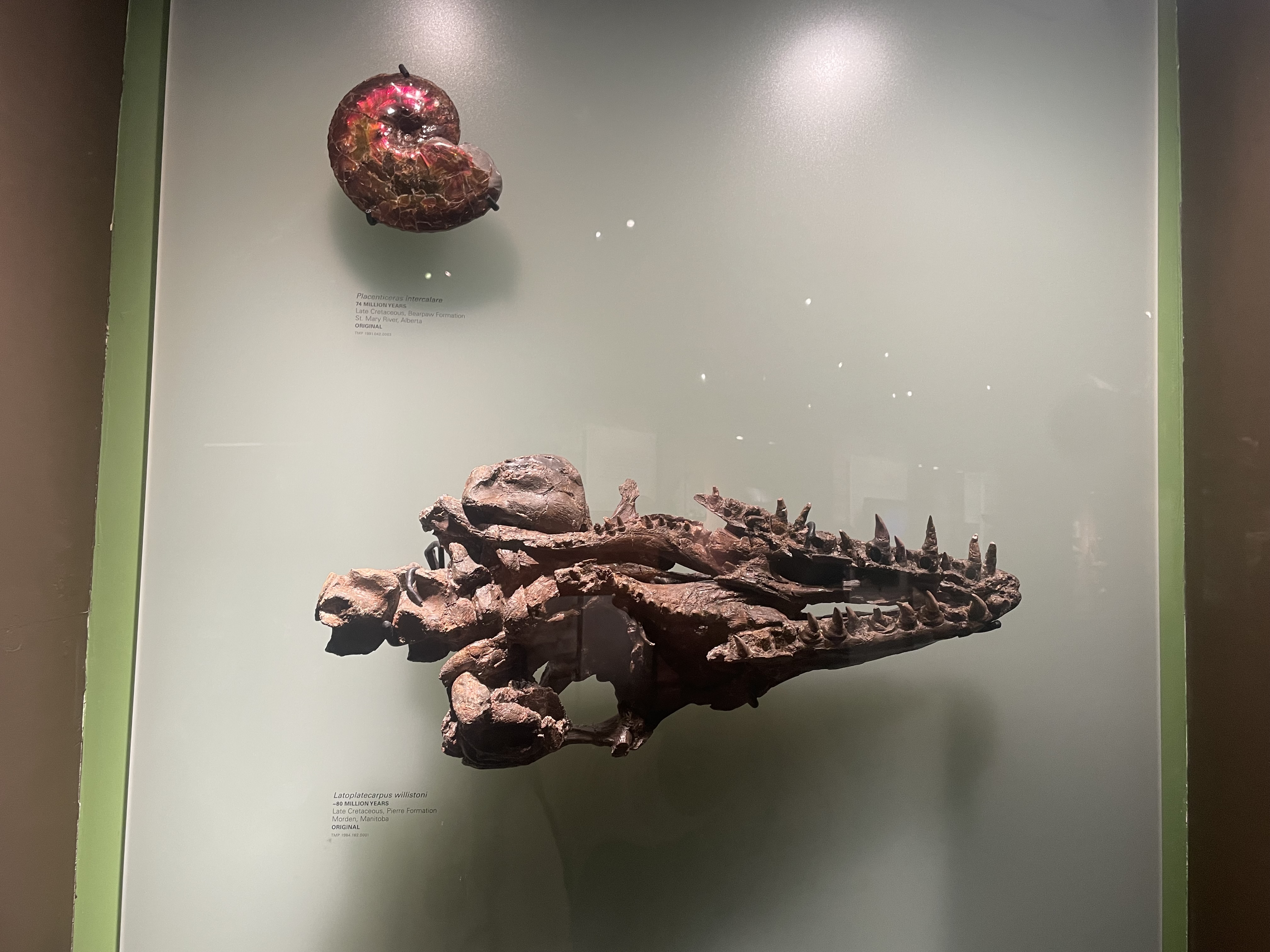
And here’s another, larger ammolite ammonite in the genus Placenticeras:
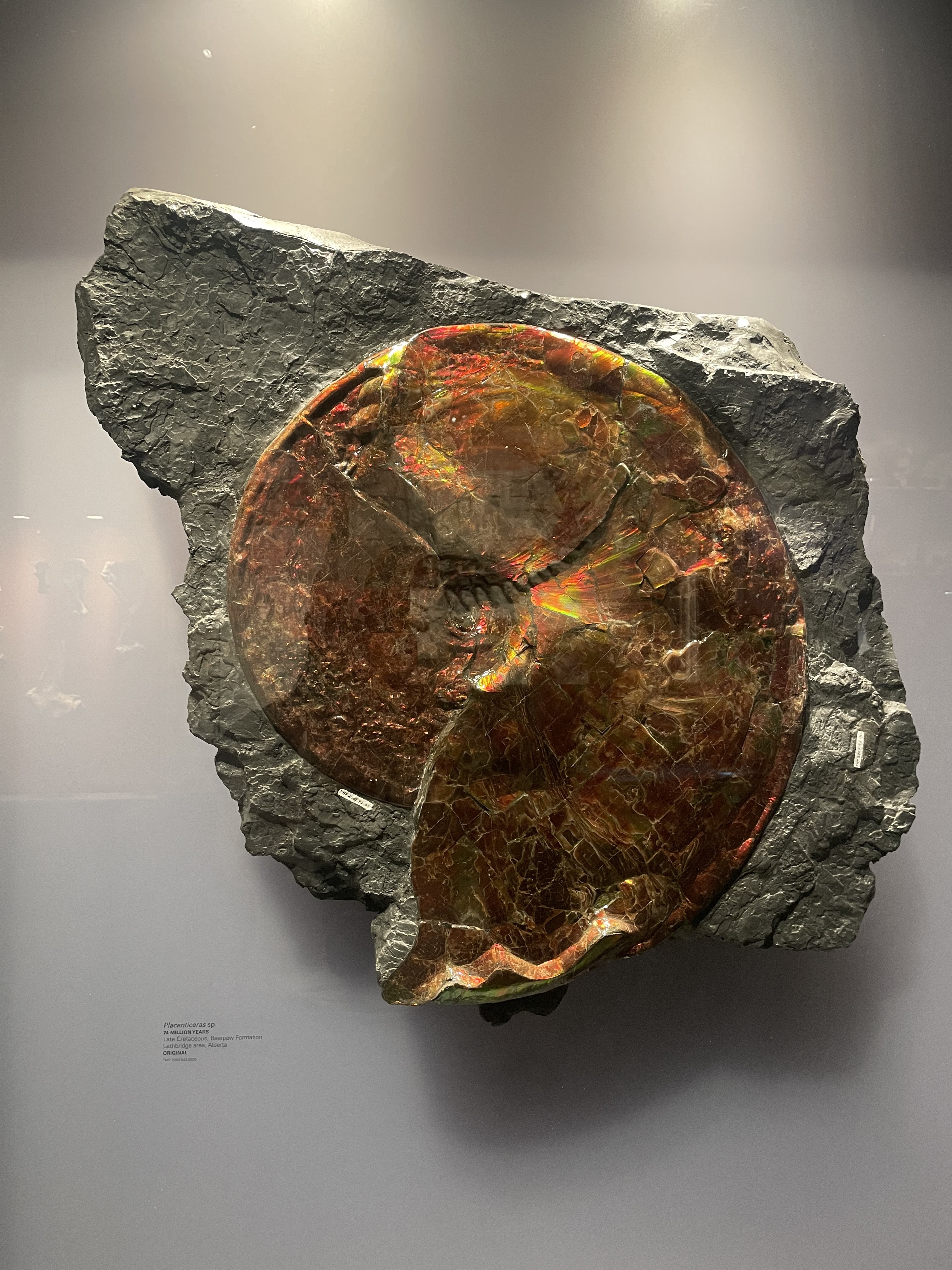
This next display highlights the difference between articulated and disarticulated fossils (and again shows off the museum’s amazing collection). Here’s an articulated juvenile Gorgosaurus (another relative of Albertosaurus and Tyrannosaurus), in the classic opisthotonic death pose that’s now thought to be a result of immersion of dinosaurs in cold freshwater after death. The mechanism still isn’t fully understood, but if you dunk a dead chicken in an ice bath, apparently it throws its head and tail back in seconds. It isn’t known why this seems only to affect dinosaurs, but my hypothesis would be a combination of neck and tail length and flexibility and the strength of the nuchal and caudal (neck and tail) ligaments that hold their heads and tails off the ground. Other animal groups exhibit some of these features, but not all: most modern animals with long tails drag them on the ground, and non-dinosaurs with long necks tend to have stiff, inflexible cervical columns. If someone has a dead giraffe on hand, could you please give it an ice bath and let me know what happens? Thanks.
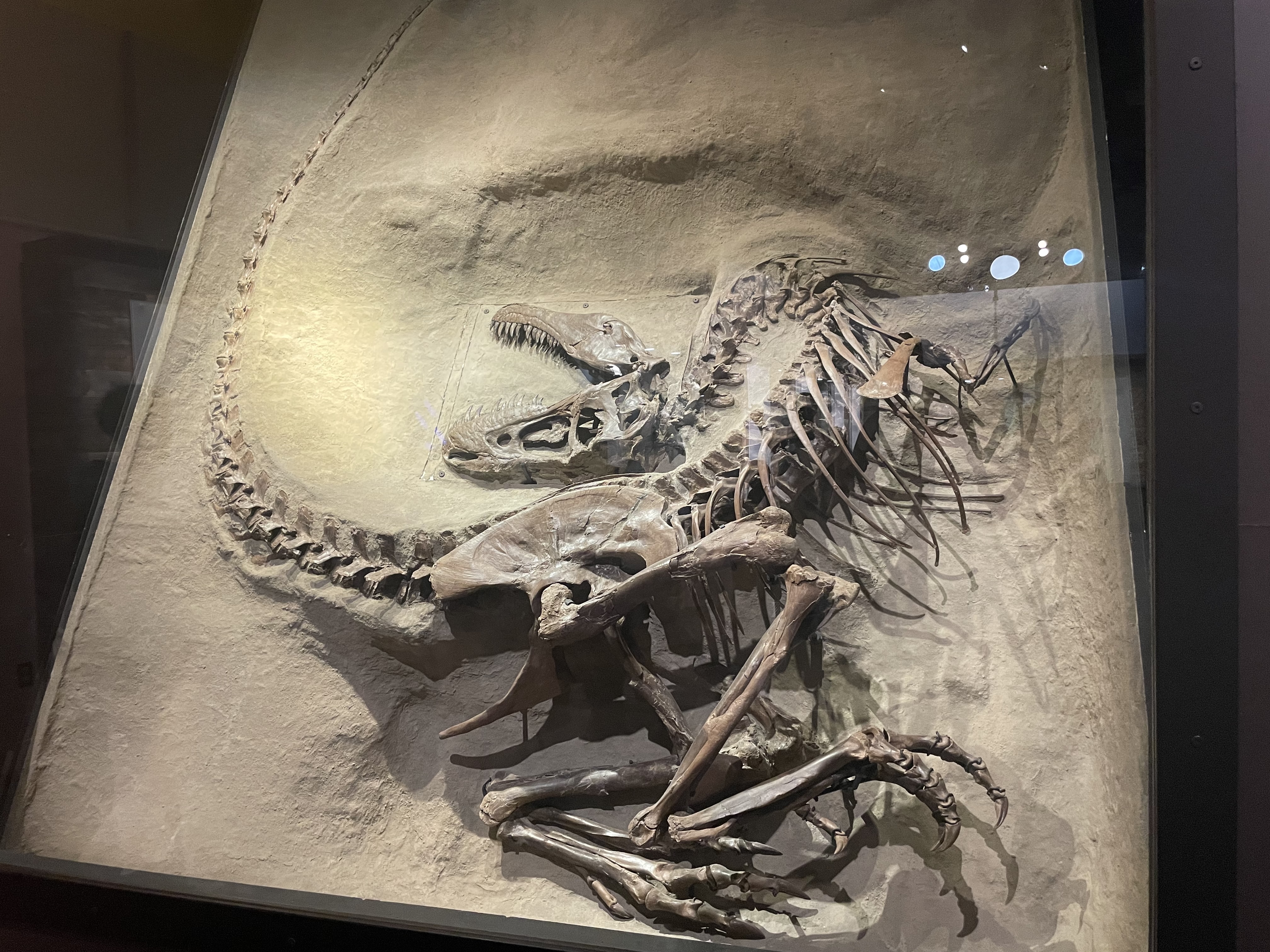
Anyway, here’s a Gorgosaurus bonebed to show what most fossil finds actually look like:
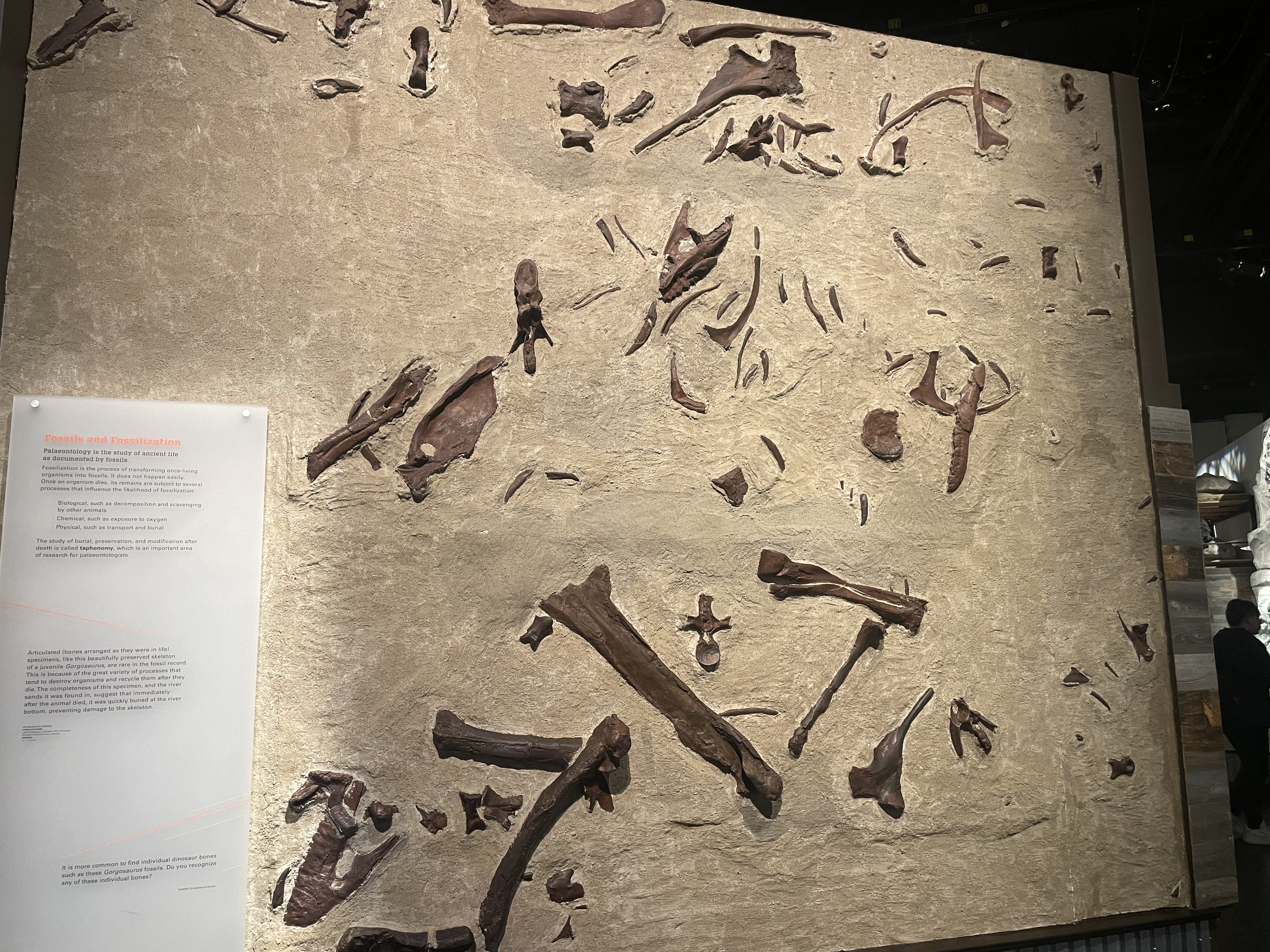
I think this is both a great way to make this point and just an amazing couple of specimens. 10 out of 10.
The next case contained a variety of different types of fossils, from bones and coprolites (poo) to footprints and skin impressions. Again, a great way to make a point and show off the impressive collection at the same time. I feel lucky to have now seen hadrosaur skin in person. 10 out of 10.
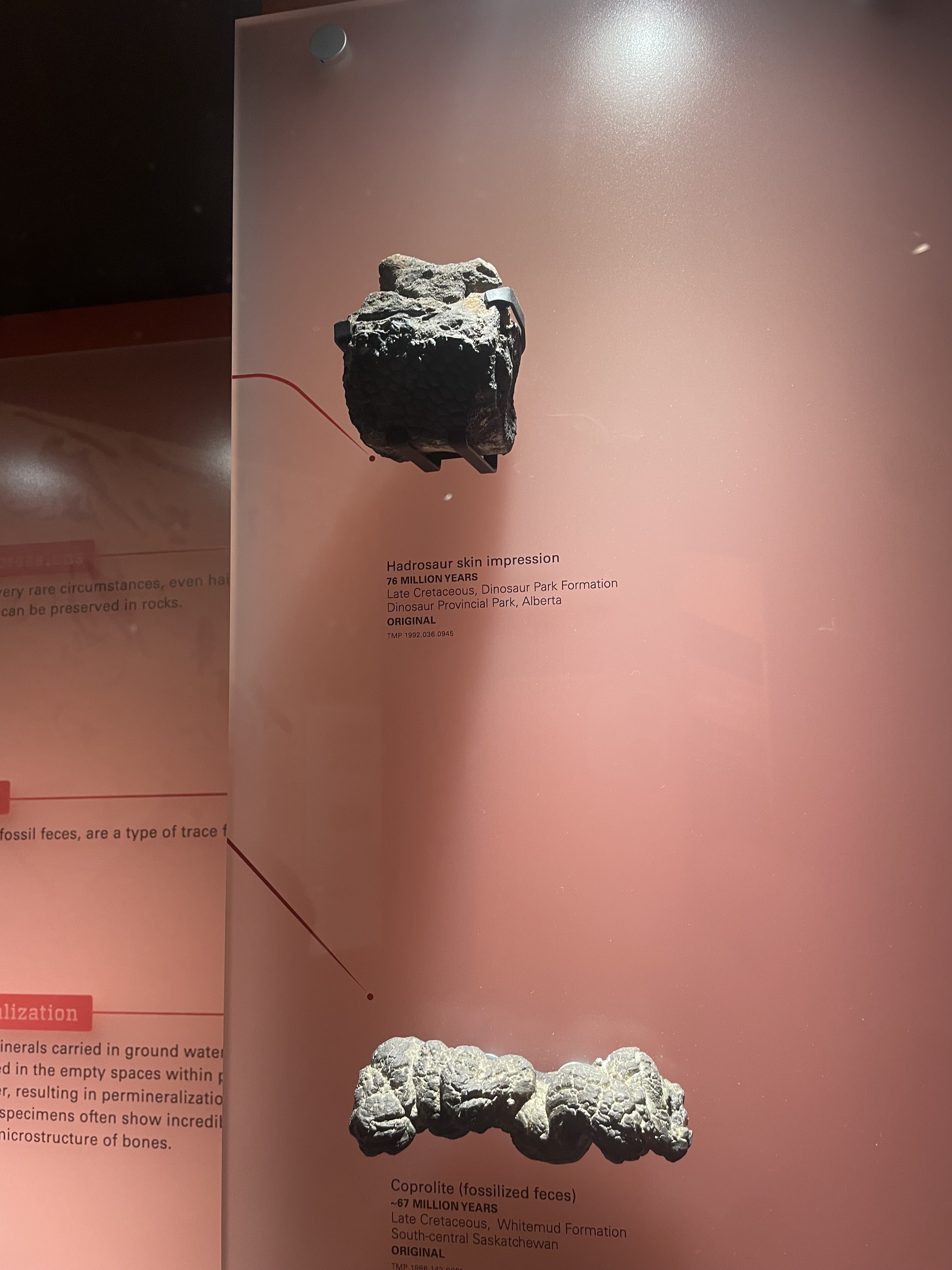
The next case contained lots of small fossils arranged in a not-to-scale timeline. While this does sort of introduce the concept of geologic time, I think it’s primarily an excuse to display fossils that didn’t make sense to put anywhere else. I think also the not-to-scale nature of the timeline is somewhat confusing. And what the heck is this Wodehousia alien pollen thingy? Googling it, I found out that it came from mud underlying a T. rex skeleton from latest Cretaceous Hell Creek, but the display doesn’t tell you that. Also, funny note, but the colors used in the timeline are semi-standardized due to Wikipedia’s color-coding convention. 8 out of 10.
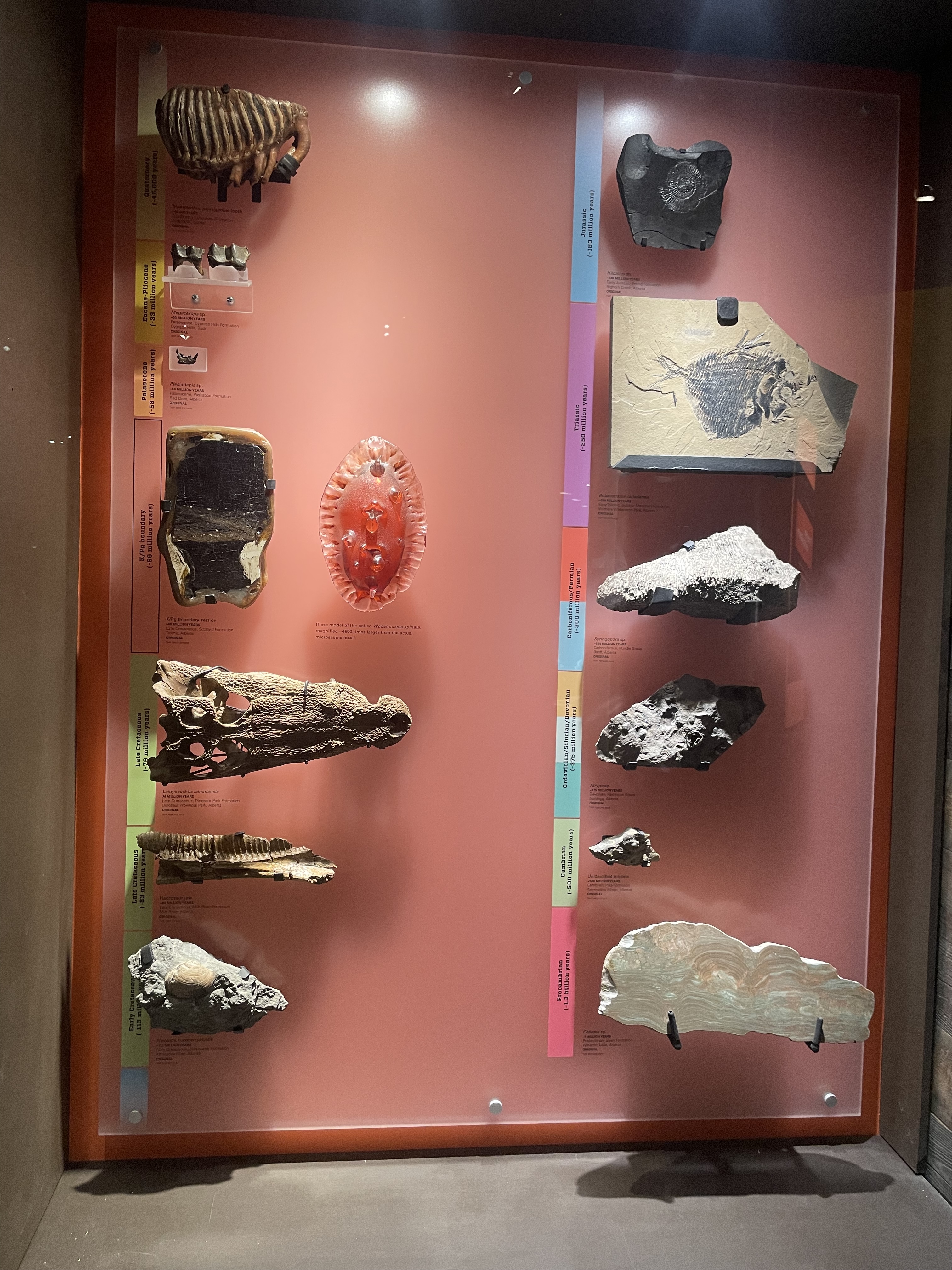
Here’s a display describing ontogeny, or the way organisms change as they grow up, using various body parts belonging to the horned dinosaur Centrosaurus. The fact that they have so many fossils, they can apples-to-apples compare growth series within a single genus is just ridiculous. 10 out of 10.
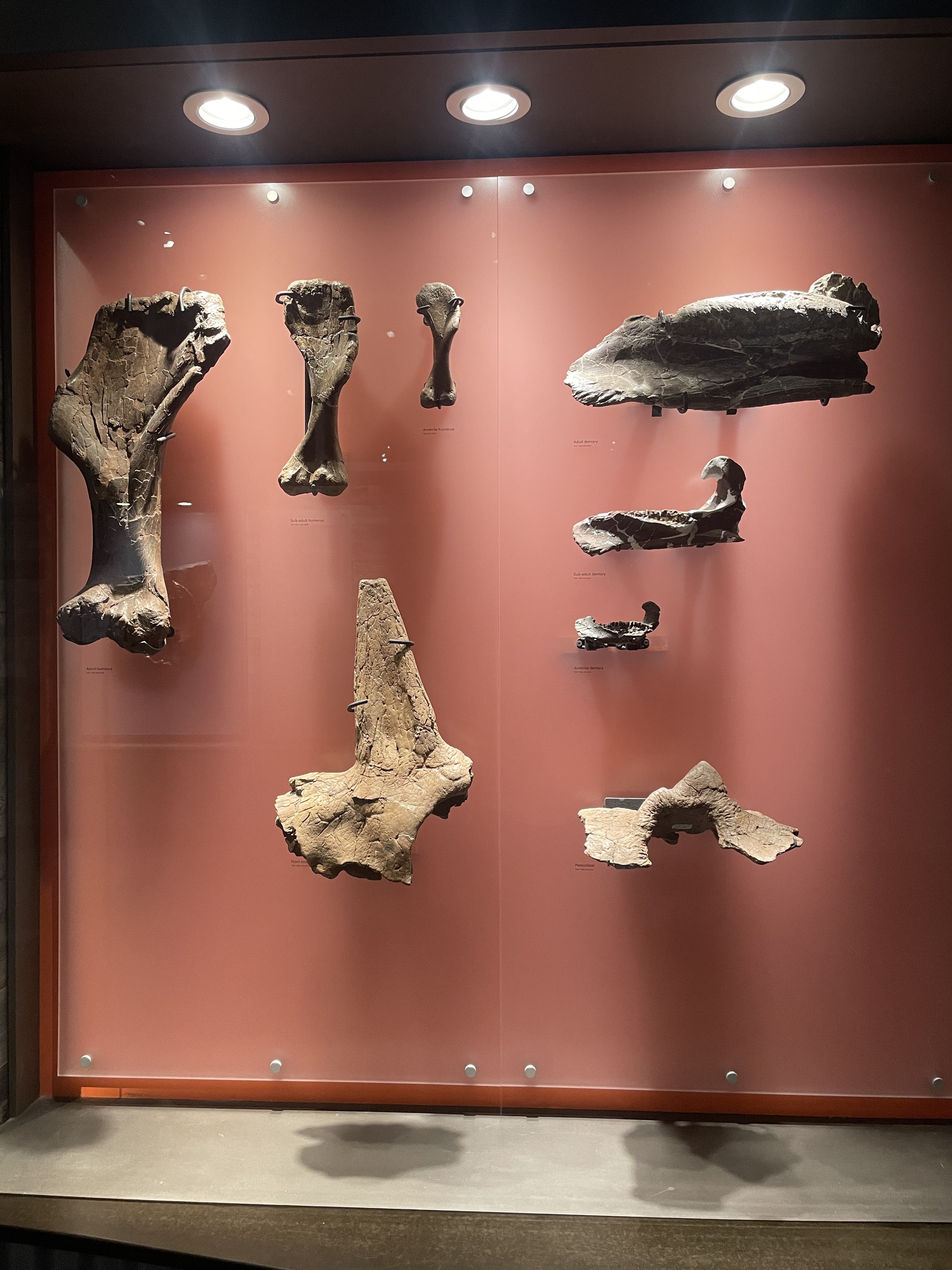
Here’s the preparators at work in the prep lab! The fossils on tables 1 and 2 are mosasaurs, but I forget exactly which genera. Always cool to see behind the scenes, and the Royal Tyrrell took the extra step of having one preparator working outside the lab so you could ask questions! 10 out of 10.
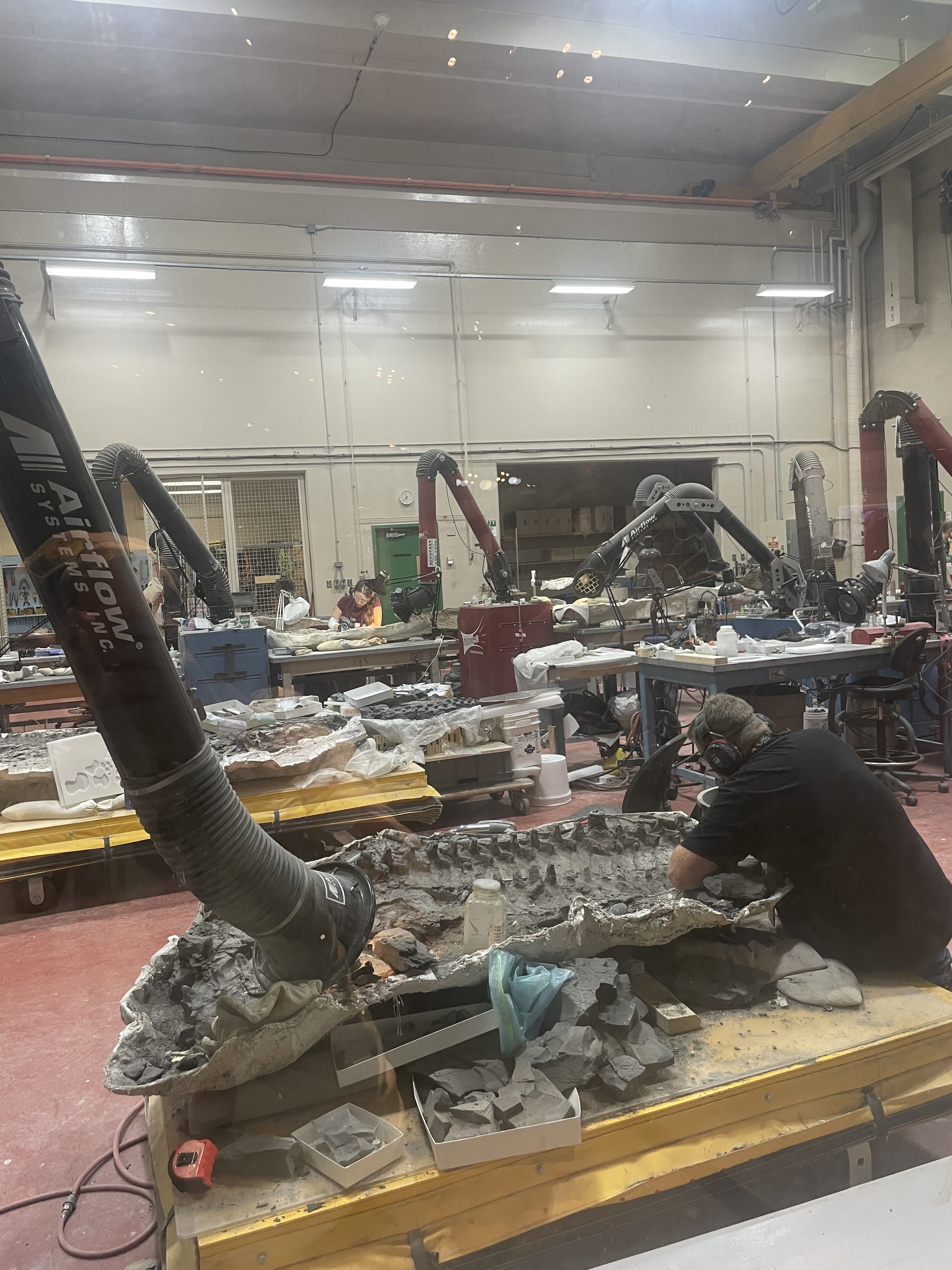
One Day At Work (“Grounds For Discovery”)
There were a surprising number of really amazing fossils in this section, which told the stories of the non-scientists who found them. I think this is a neat idea, since it gives the non-scientists who visit the museum an idea of how people like them have contributed, and it also honors those whose names don’t make it into the scientific papers but are a necessary part of the process of discovery nevertheless.
This Mosasaurus skeleton was not only quite complete (and wouldn’t all fit in one photo), but it has a tooth from another member of its same species stuck in its jaw! It was probably attacked from below. This specimen was found while mining for ammolite ammonites to use in jewelry. I know that not because I remembered to take a picture of the sign, because I didn’t, but because the Royal Tyrrell is proactive about making info about its fossils available online. Best.

This small plesiosaur known as Nichollssaura (one of the many things named after paleontologist Betsy Nicholls) is highly complete and articulated, is the holotype for the species, fills a gap in plesiosaur evolution, being from the Early Cretaceous, and contains gastroliths (gizzard stones) that were revealed when a…happy accident… with a saw cut the specimen in half. Whoops! This one was discovered while mining for bitumen.
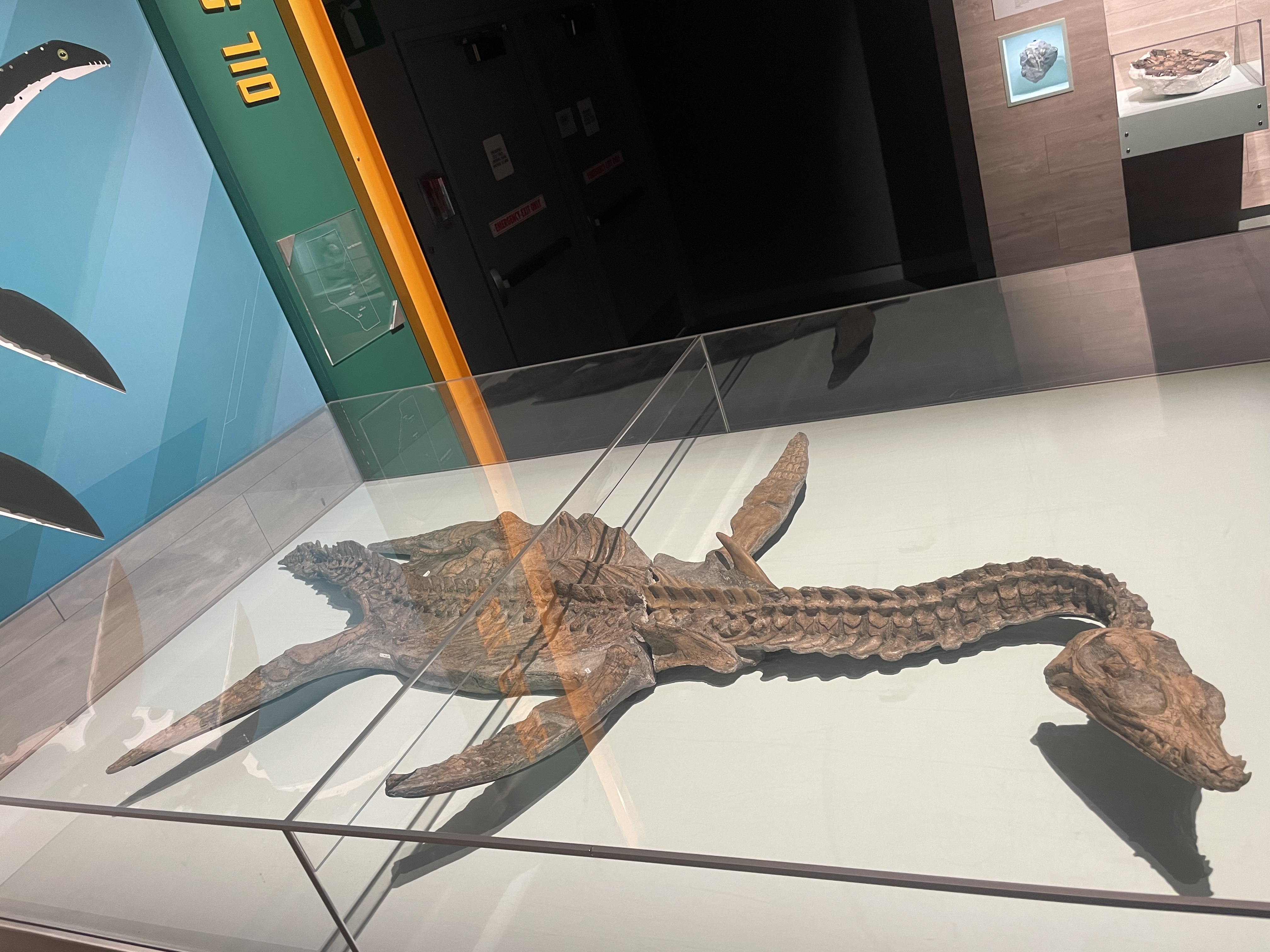
This Cretaceous sea turtle known as Nichollsemys has a comic associated with it that tells the story of its discovery. However, I think the final line is a bit ironic… is this turtle skull really that important? Is it in any history books?
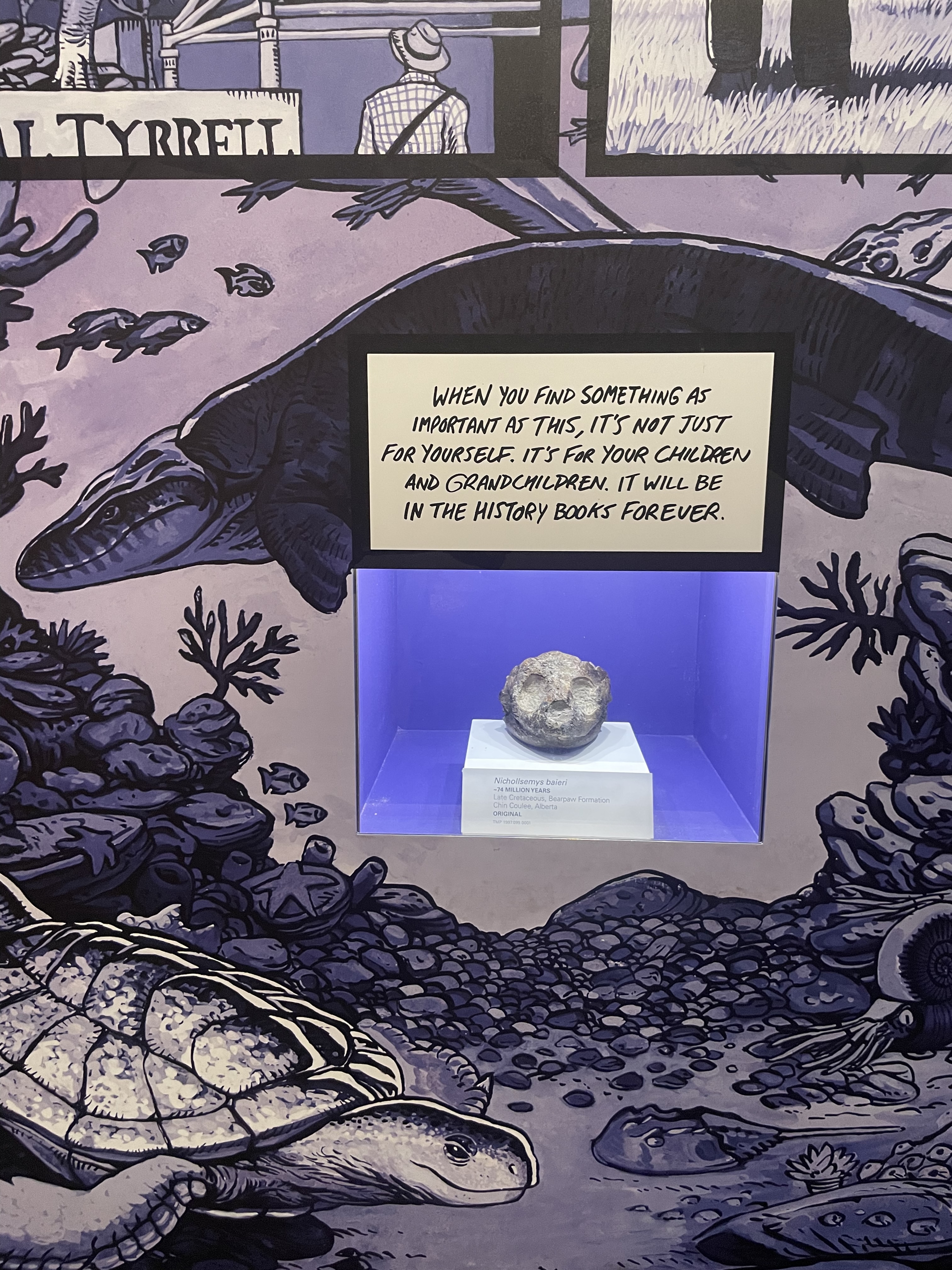
This hadrosaur tail preserves the ossified tendons that formed a strong, woven-basket type structure that would have kept the tail very stiff.
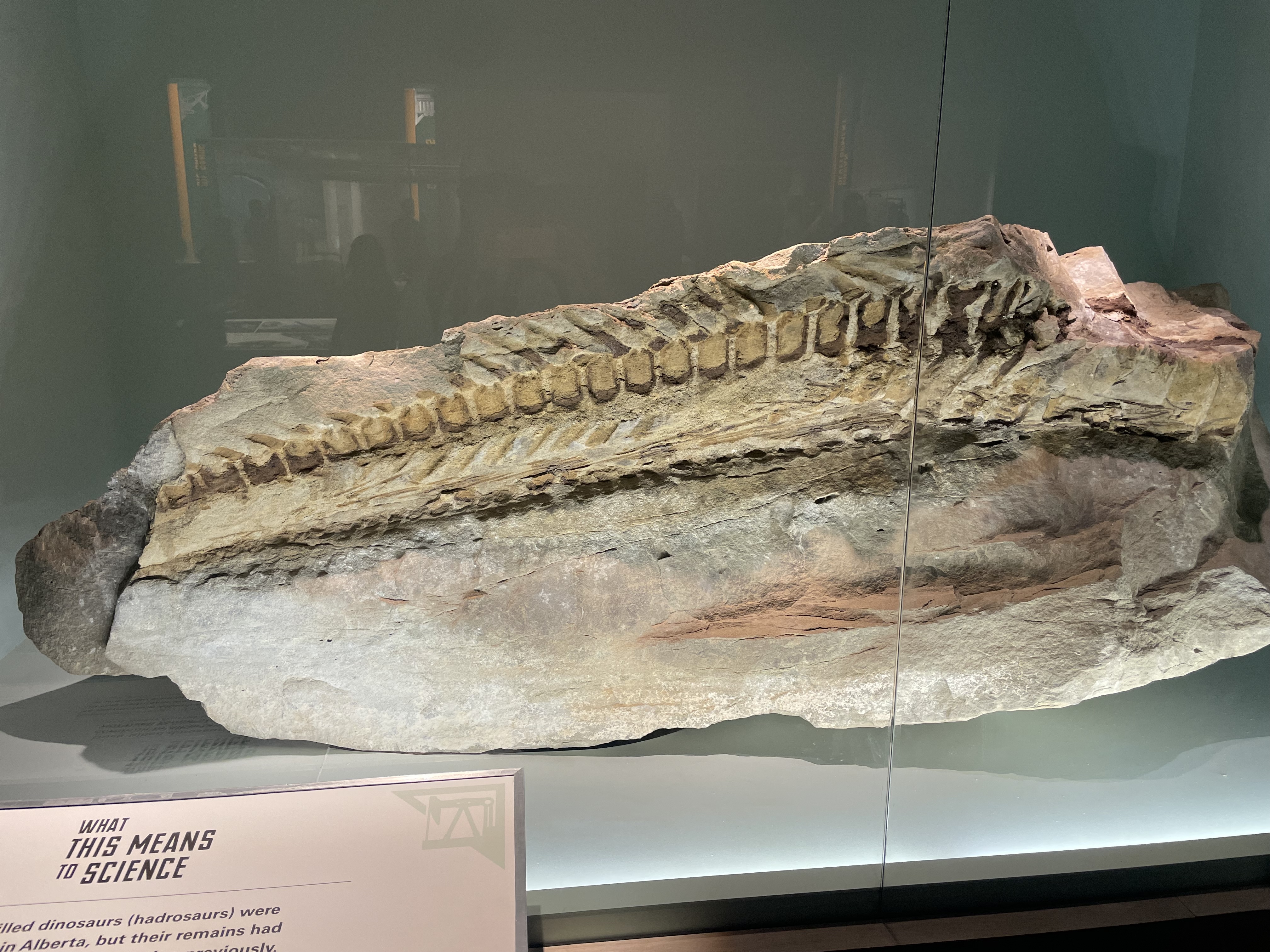
This slab preserves three distinct theropod trackways, and was discovered during coal mining. However, the way that this was displayed involved flashing colored lights lighting up the individual footprints, timed to annoying stomping noises, and I had to wait for this to cycle through before I could get a picture of the whole slab when it was fully lit up for just a second.
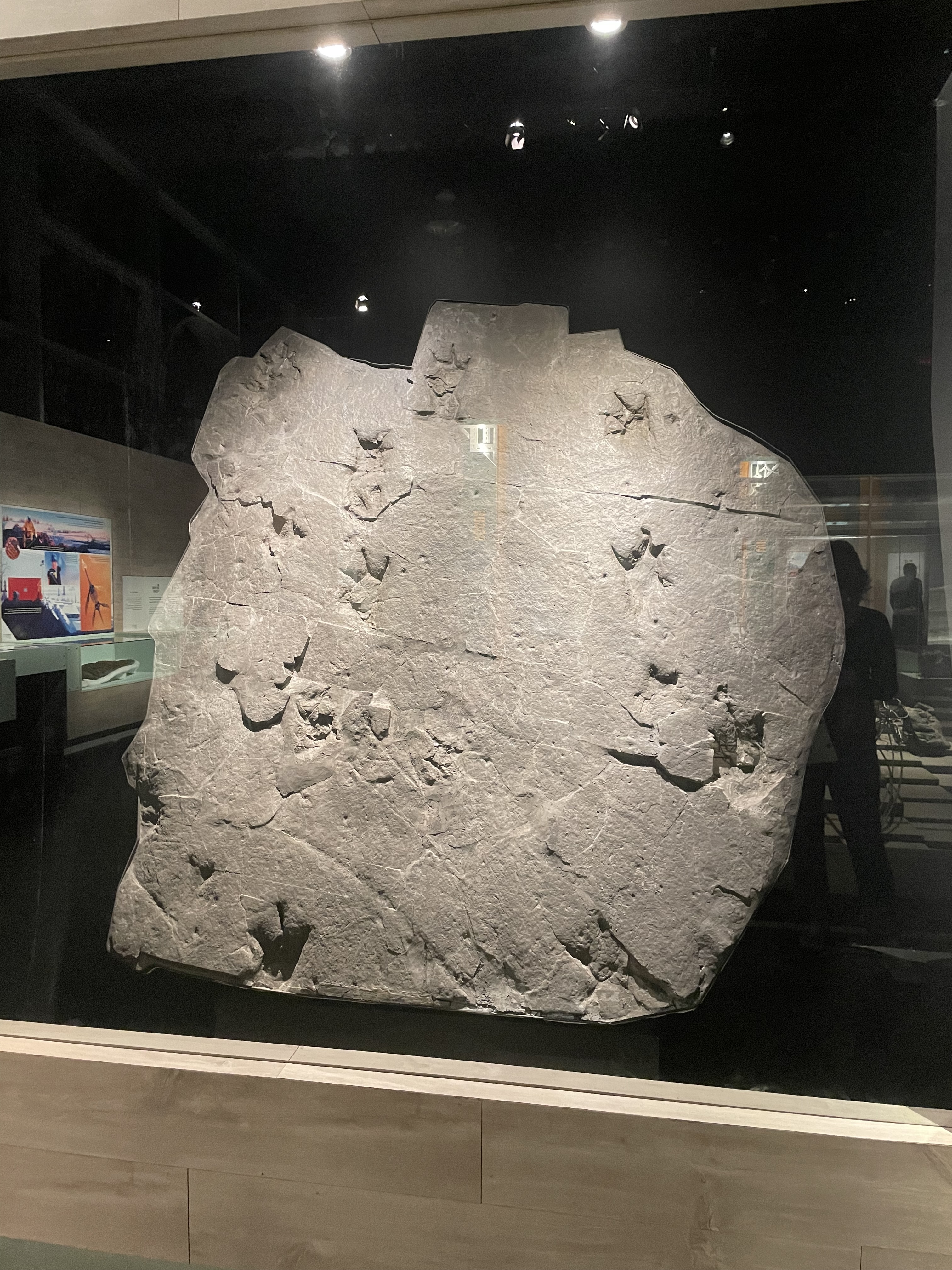
Here’s a rare post-Cretaceous fossil, an unnamed pantodont, or large mammal from the Paleocene. After the non-avian dinosaurs were wiped out, mammals rushed to fill the available niches, reaching large body sizes in just a couple million years. Pantodonts were bearlike generalists that were supplanted by more specialized mammal lineages as time went on. One weird thing about this specimen is it kept calling it simply a pantodont without specifying its genus, but simultaneously claimed that this specimen represented a newly described genus and species.
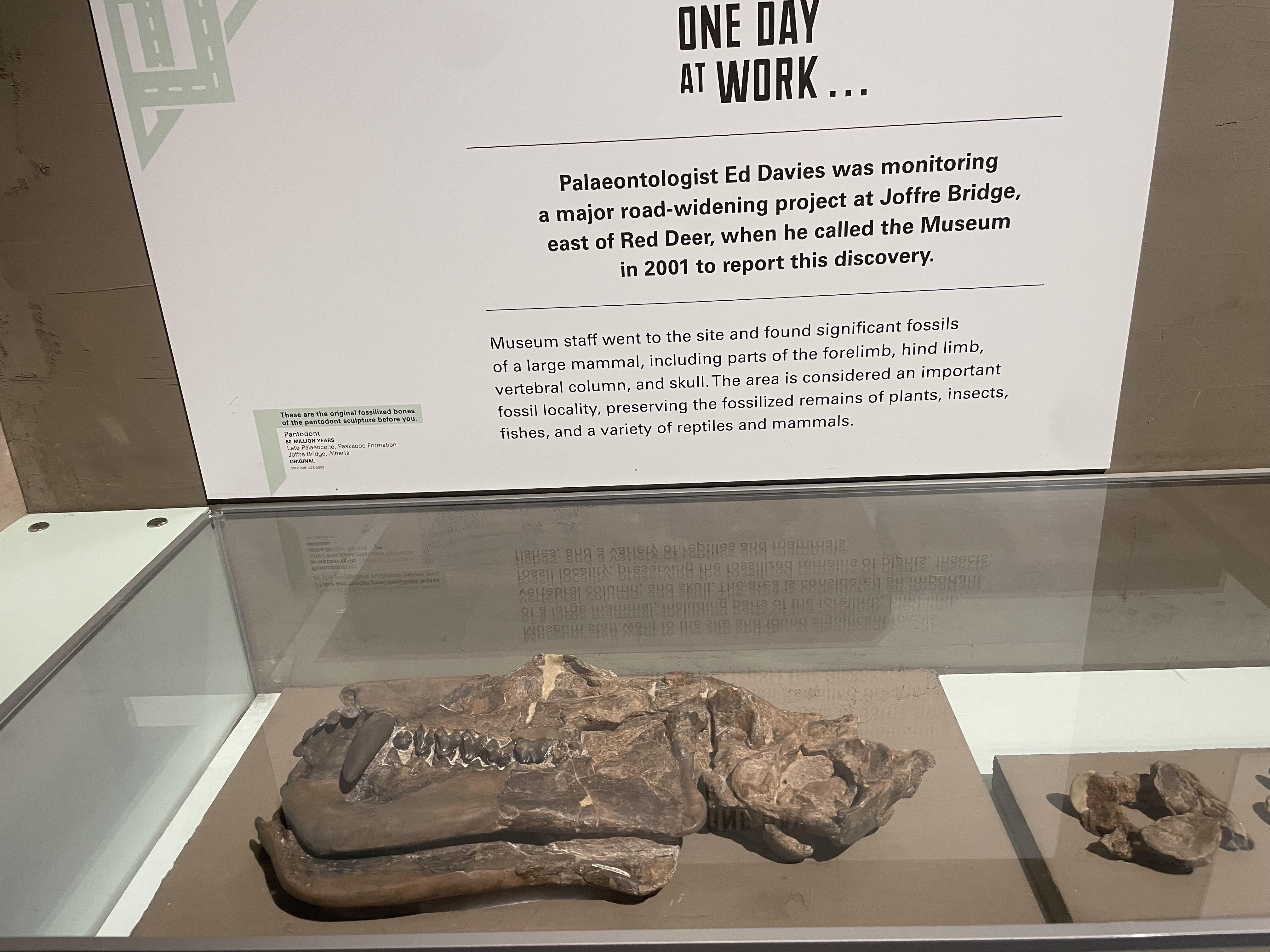
I thought this method of displaying the casts was cool and artsy.
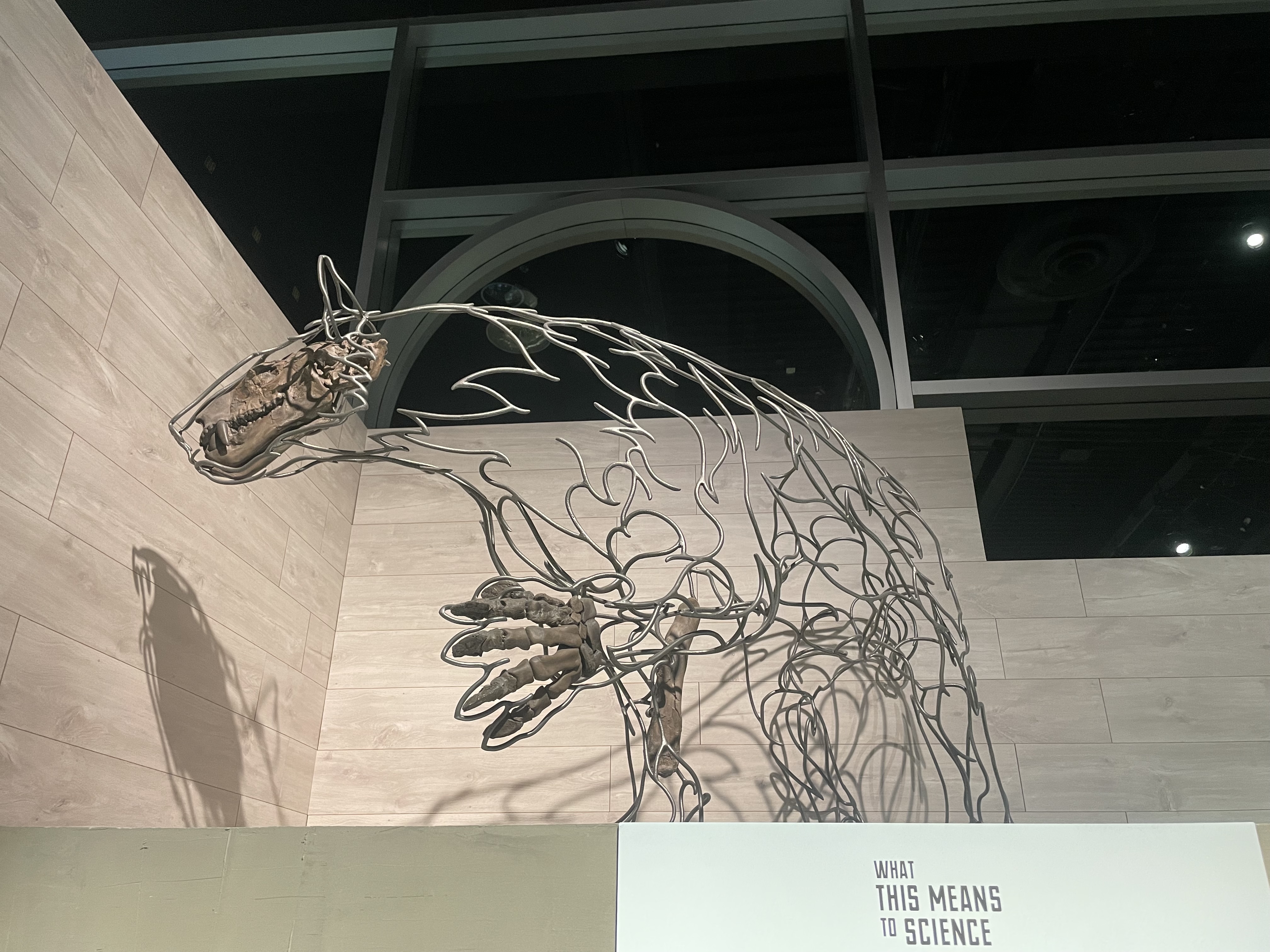
Overall, I’d give the “Grounds for Discovery” exhibit (outside of Borealopelta, which was technically part of it but deserved a rating of its own) a 9.5 out of 10. Really well done, but with just a couple things I would’ve done differently.
Surplus Fossils
One thing the museum had in spades was ceratopsian (horned dinosaur) and hadrosaur (duck-billed dinosaur) skulls. They just had skulls coming out their ears, more skulls than they knew what to do with. Insane. Here are some hadrosaur skulls, Brachylophosaurus and Corythosaurus:
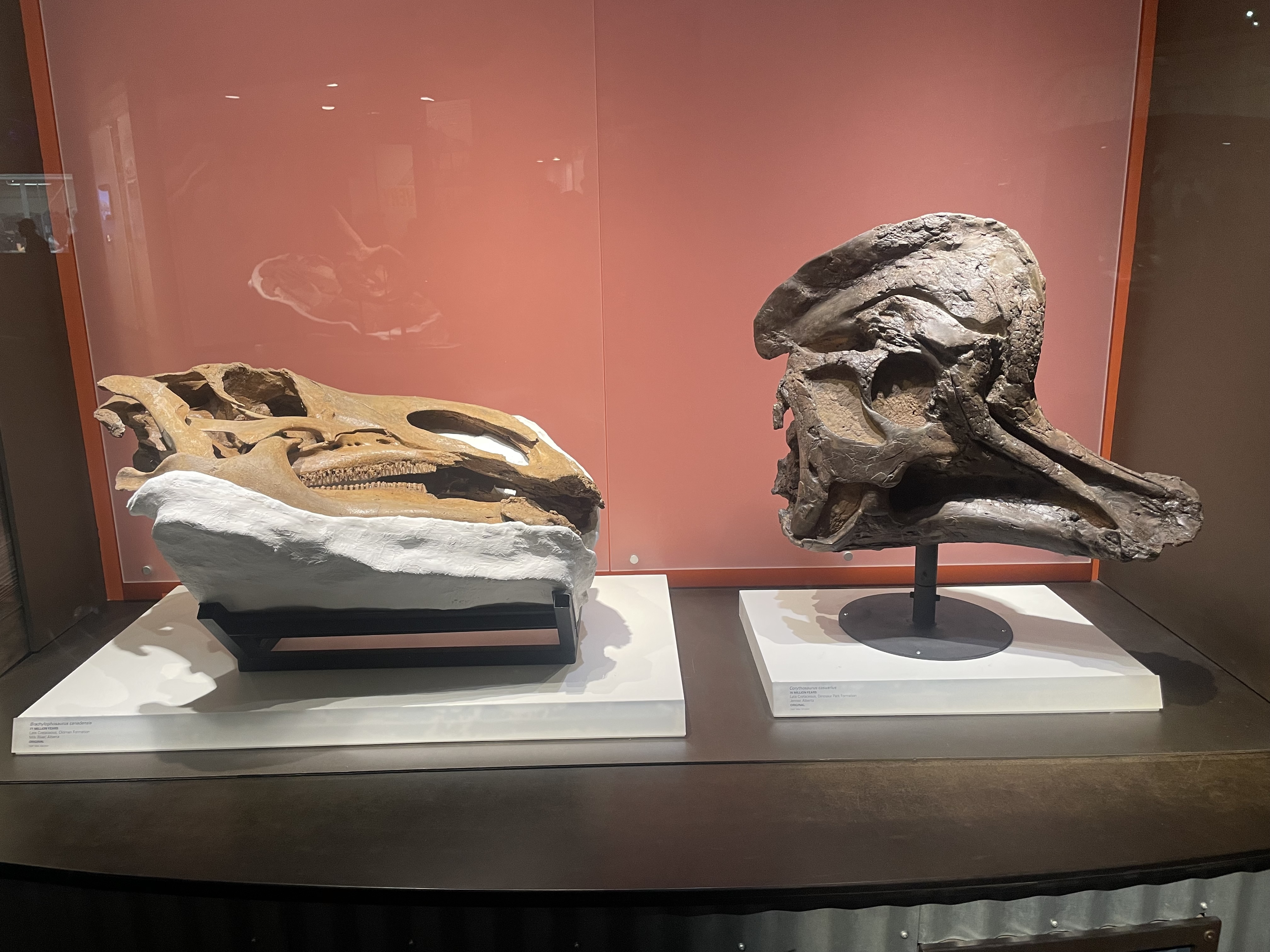
A Lambeosaurus (hatchet head) skull that’s deformed so that its snout is shorter than it would’ve been in life:
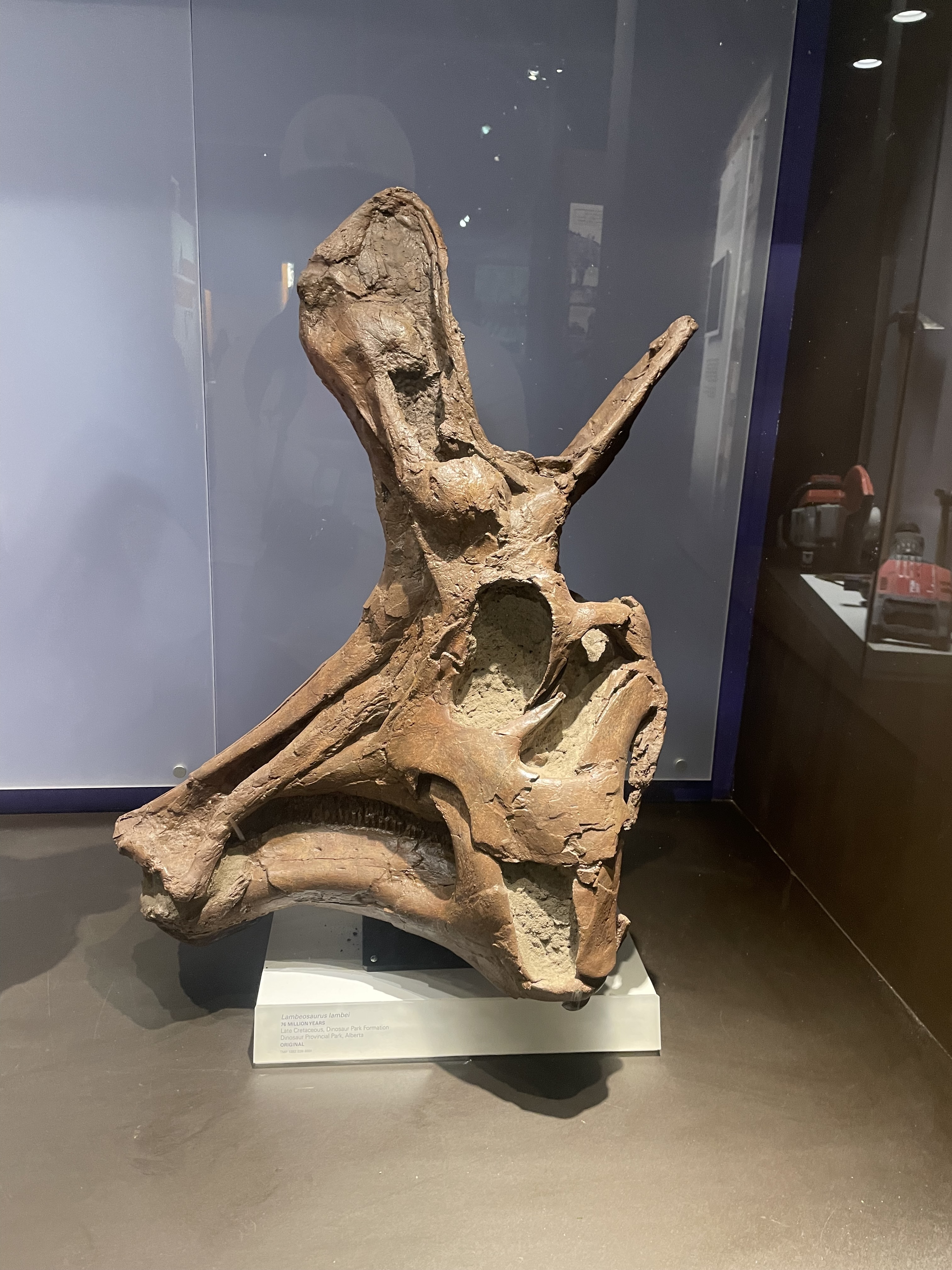
A Centrosaurus skull:
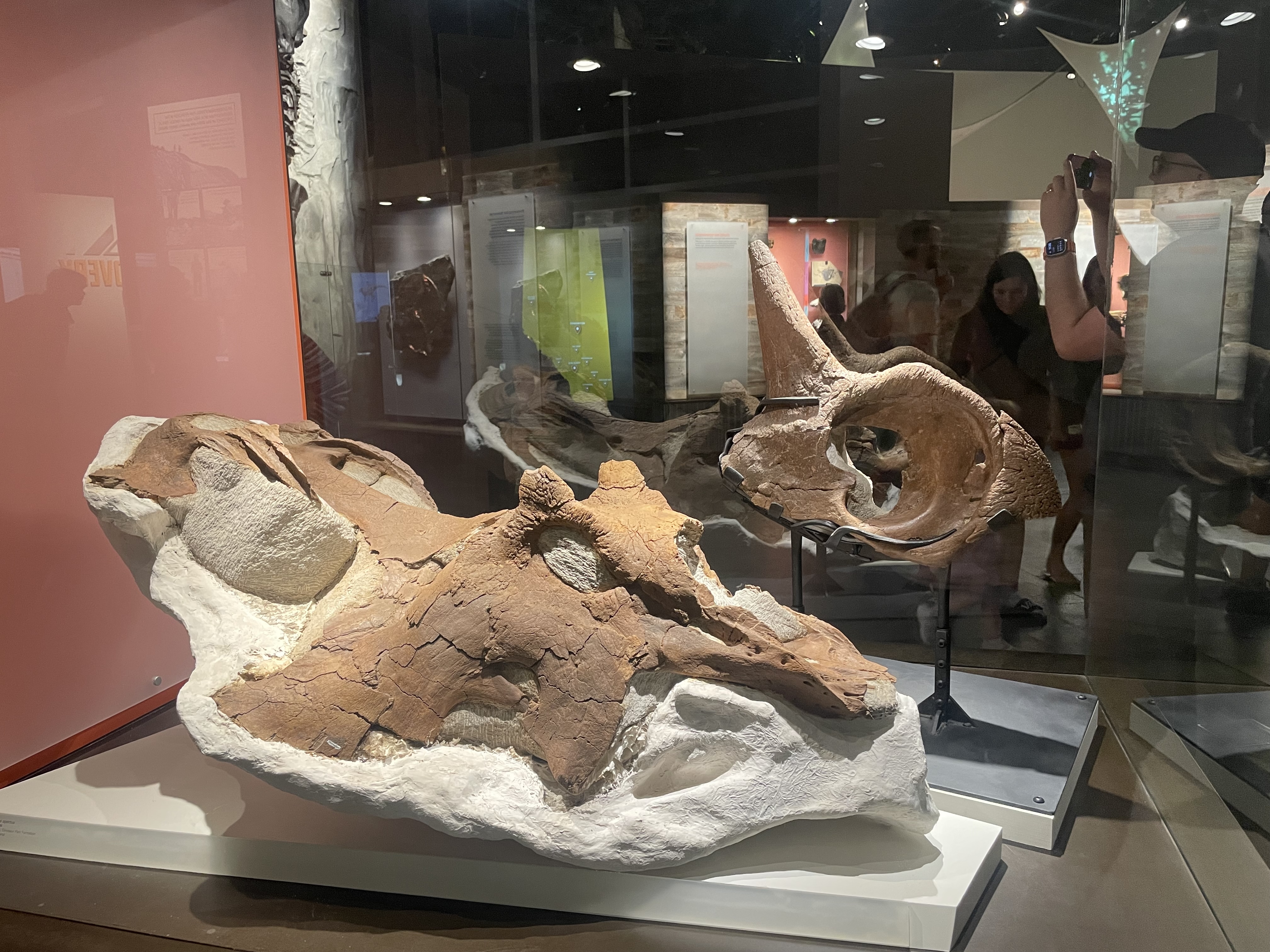
And a Regaliceratops skull:
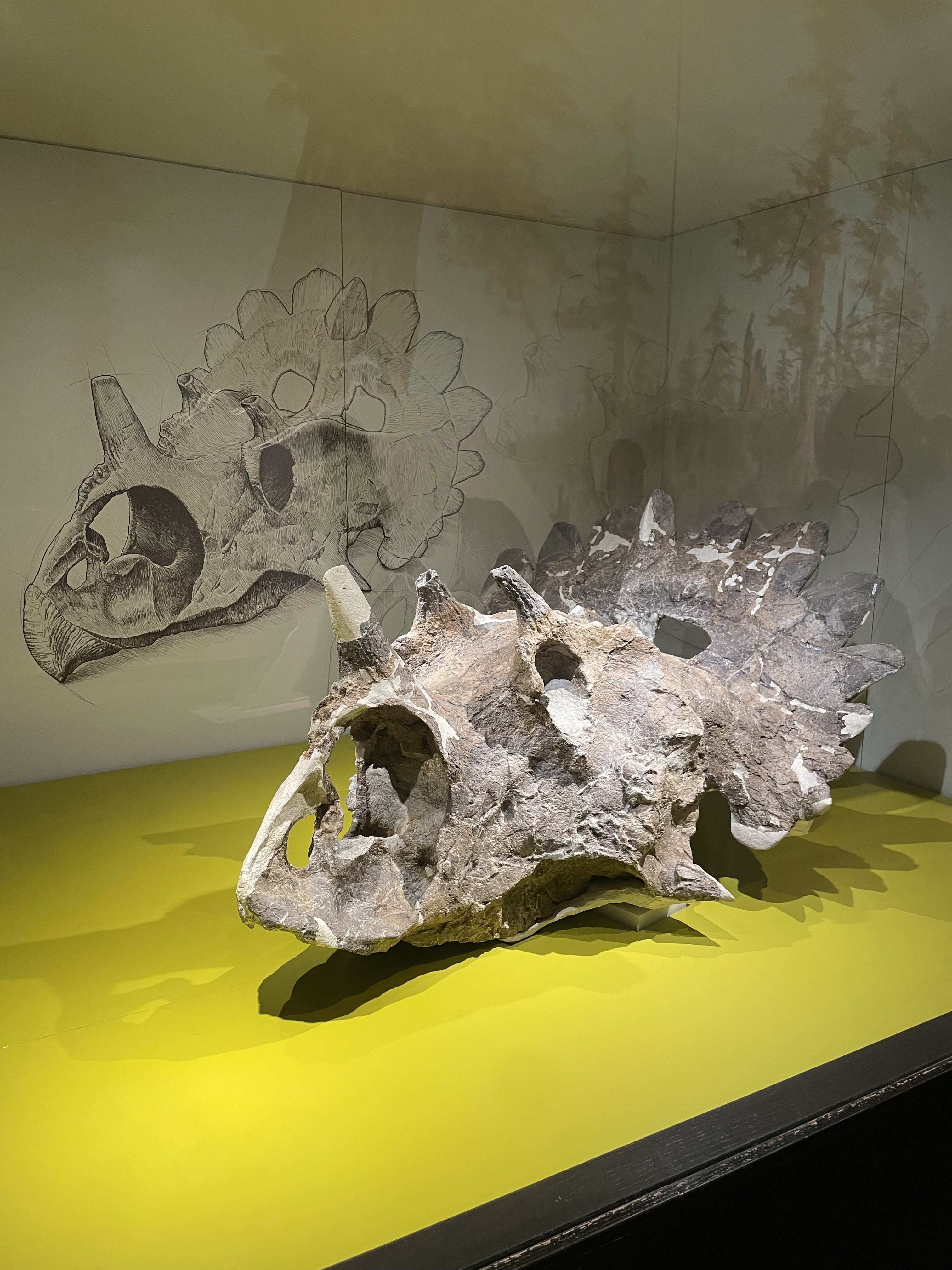
And some that hadn’t been mounted yet (Chasmosaurus, Dilophosaurus, Gorgosaurus), and some mysteries in plaster:

And below some of these skulls were drawers you could open with more surplus fossils, like this fish:
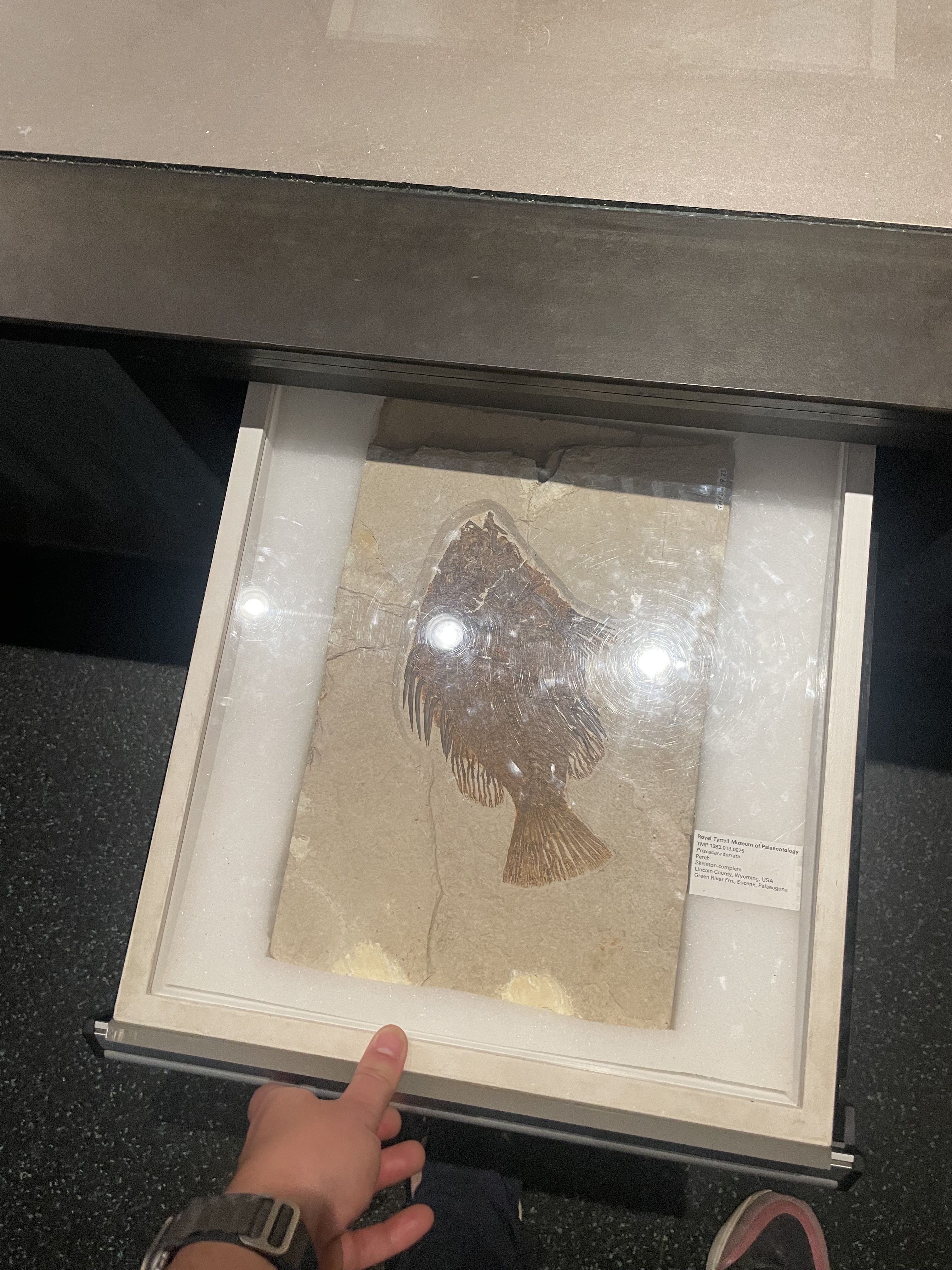
Just wow. I like the fact that, even though the exhibit designers couldn’t really think of a point to make with these, they’re still on display for me to appreciate. These are just the ones that didn’t make it into the main extended-format timeline exhibit, which is also jam-packed with skulls. More to come later!

